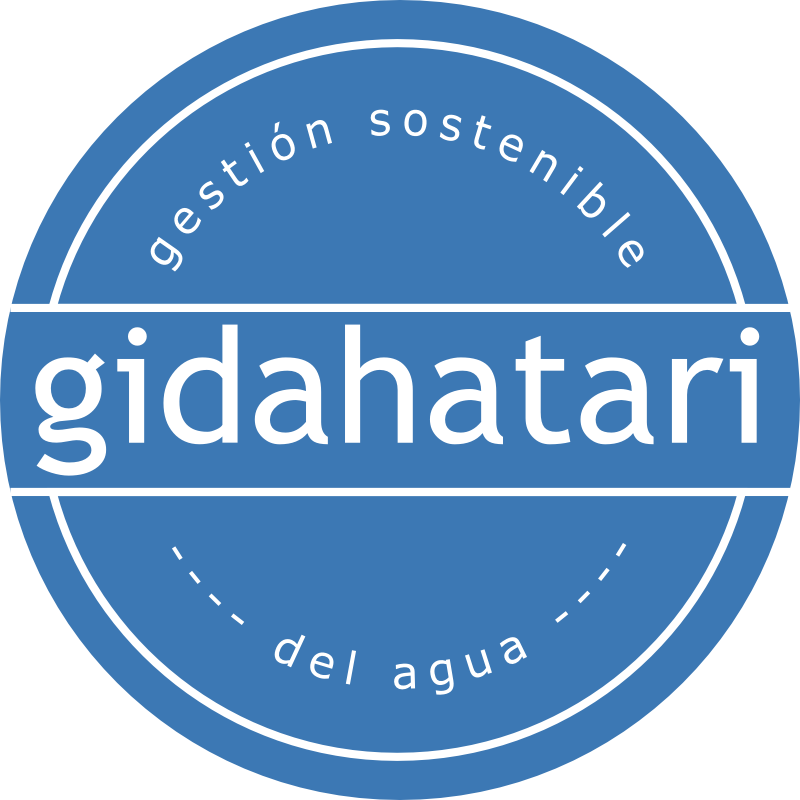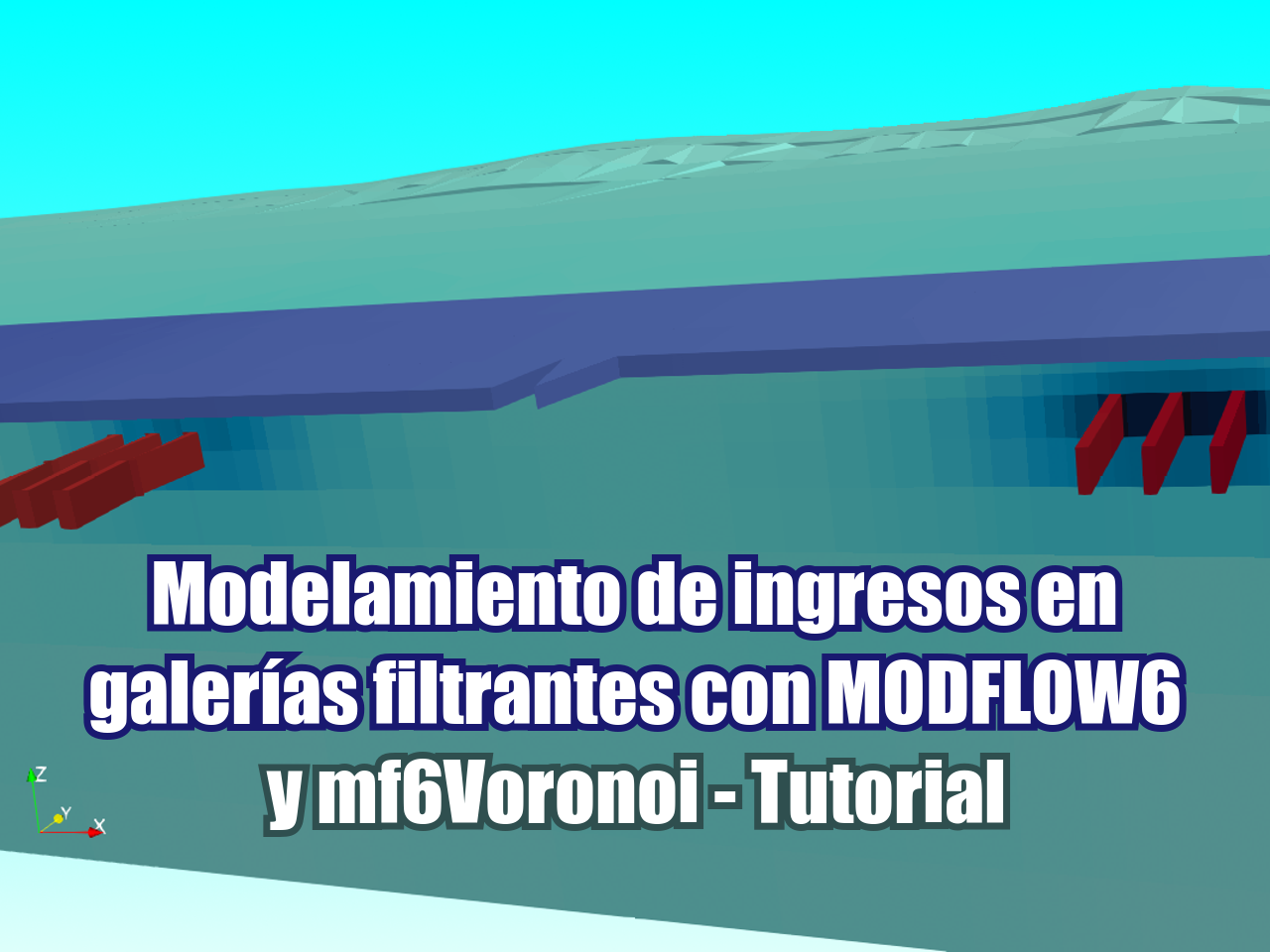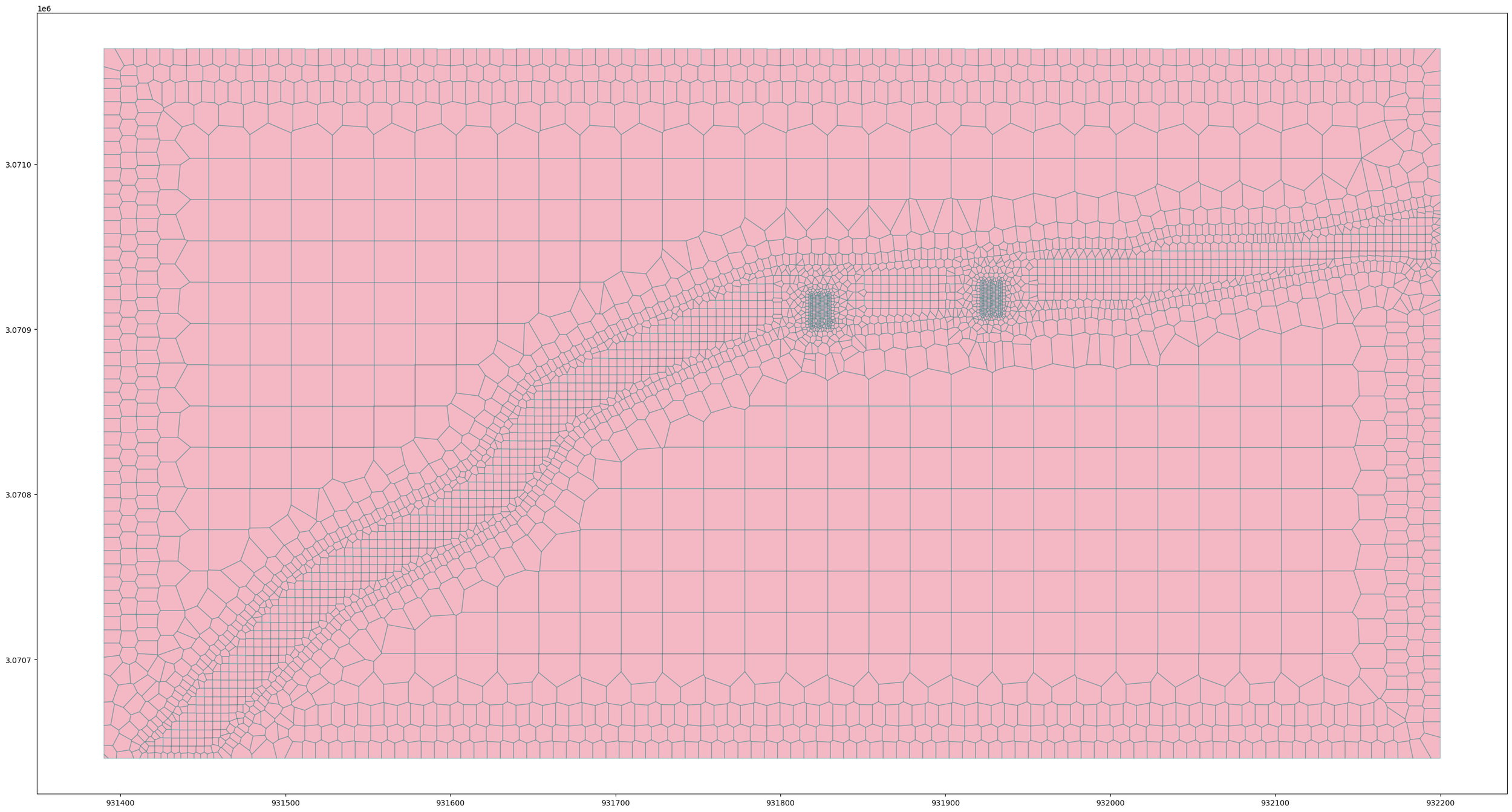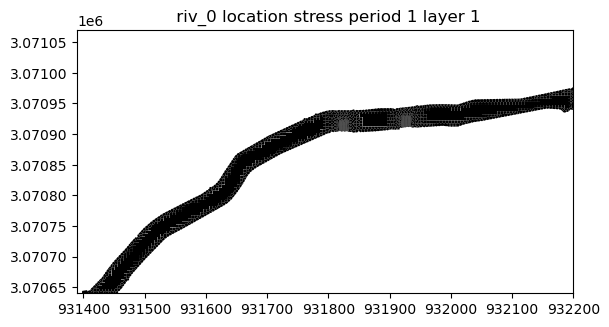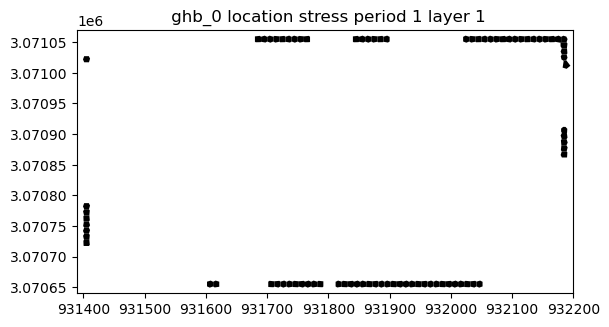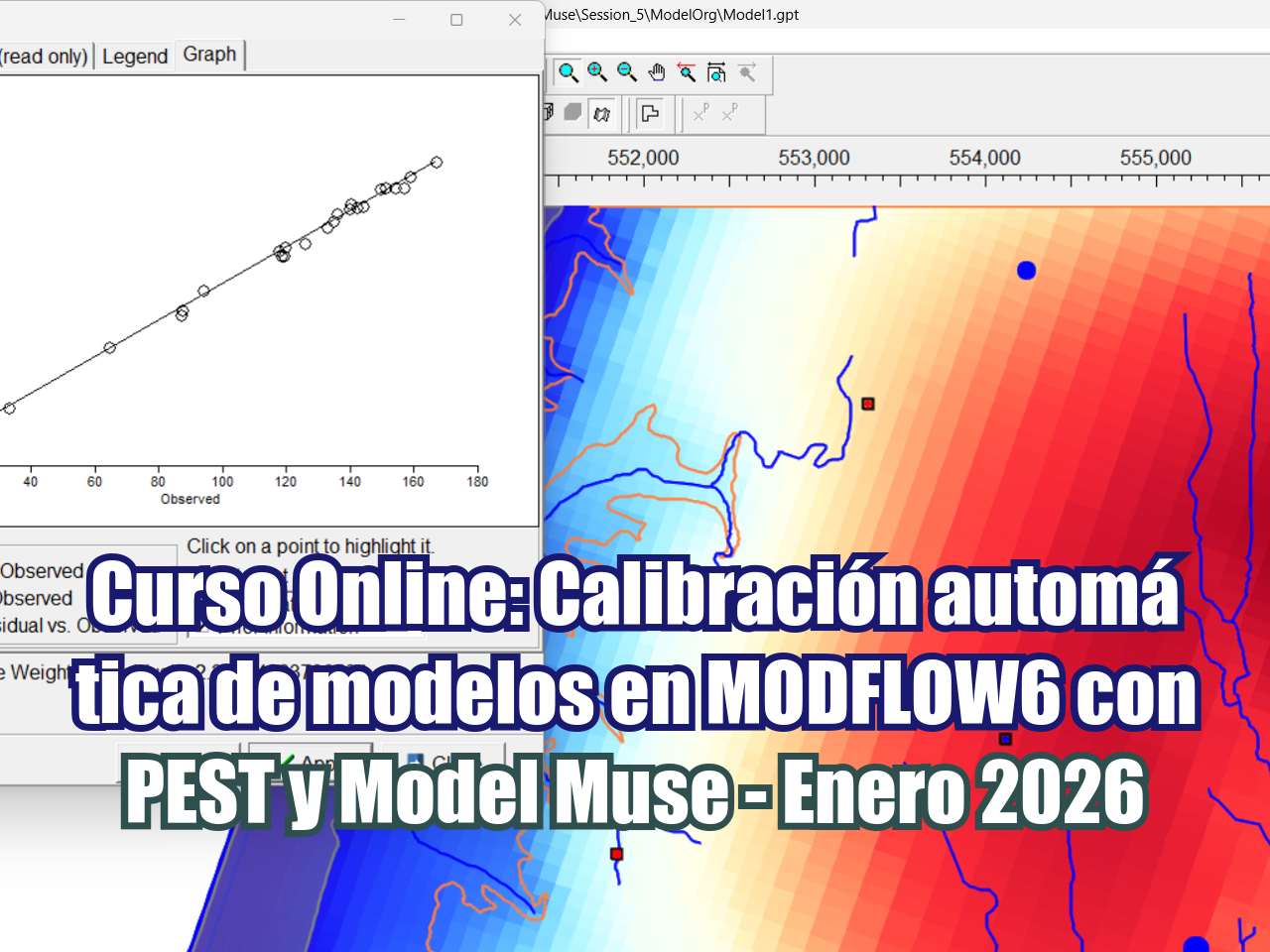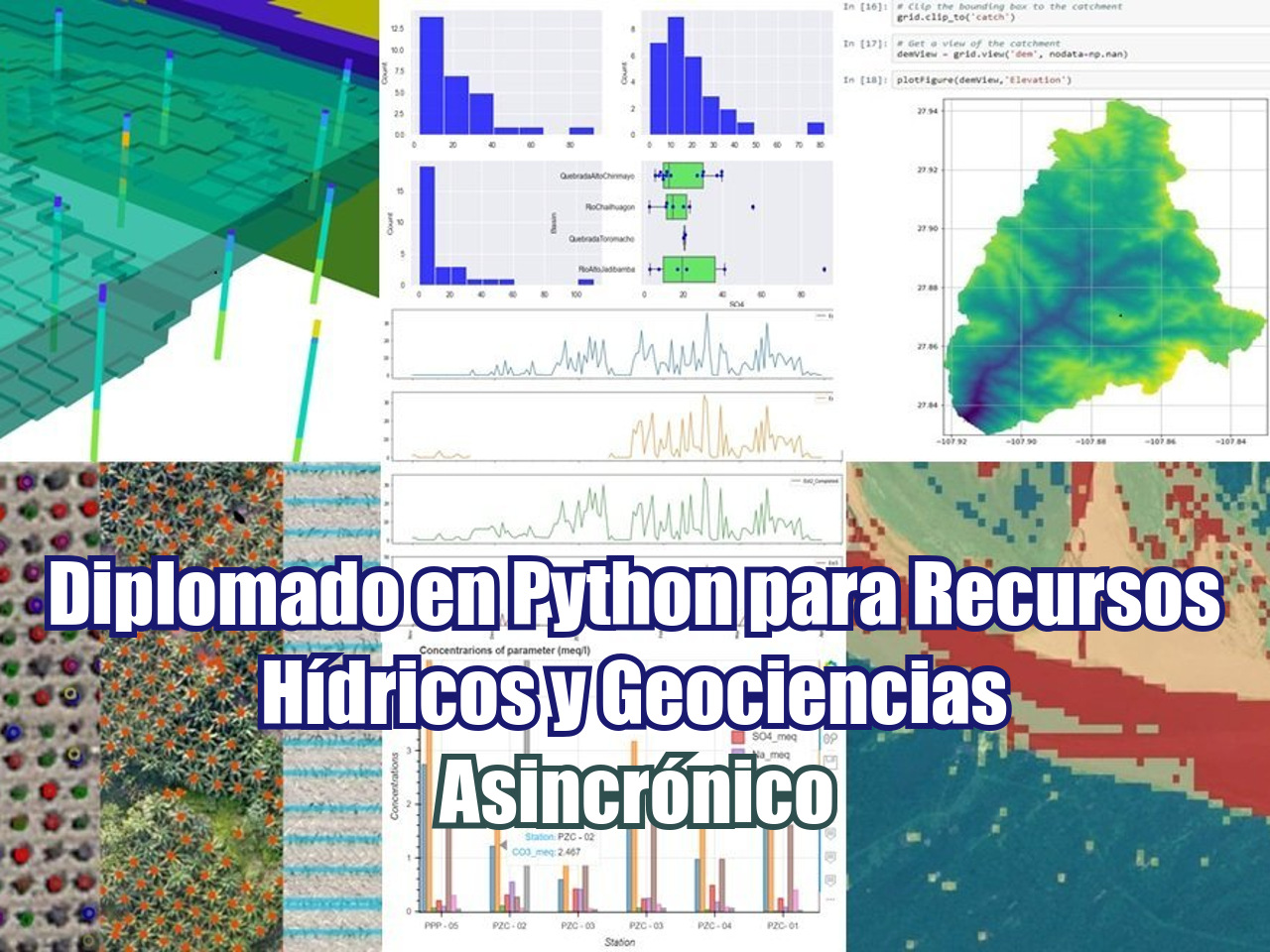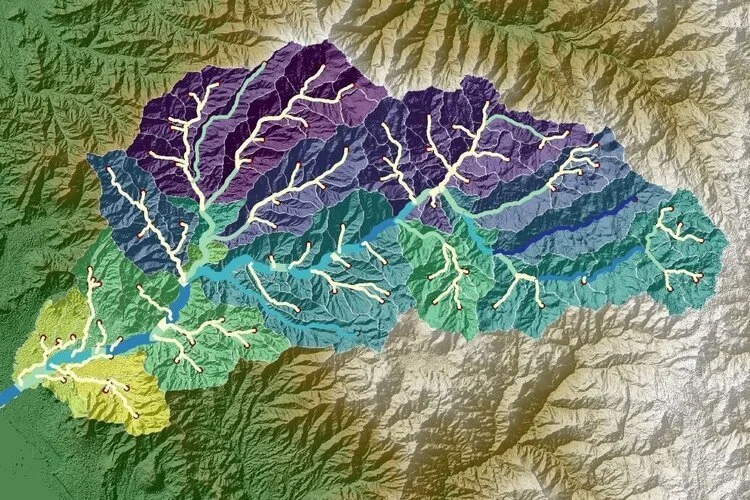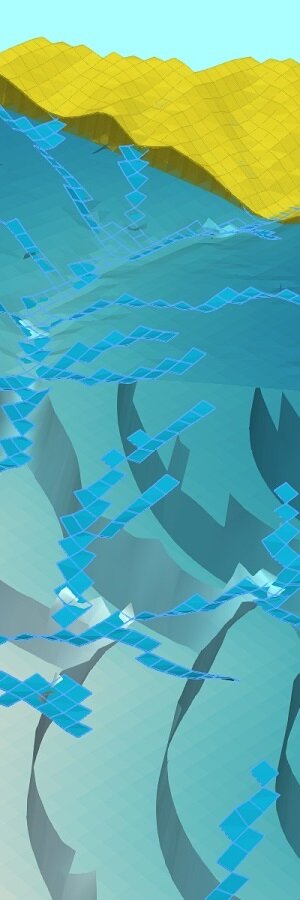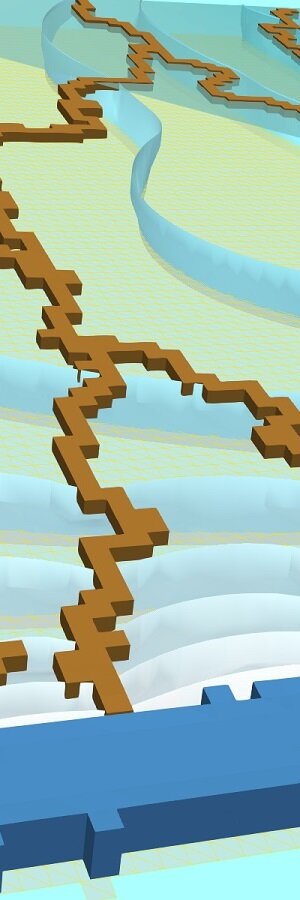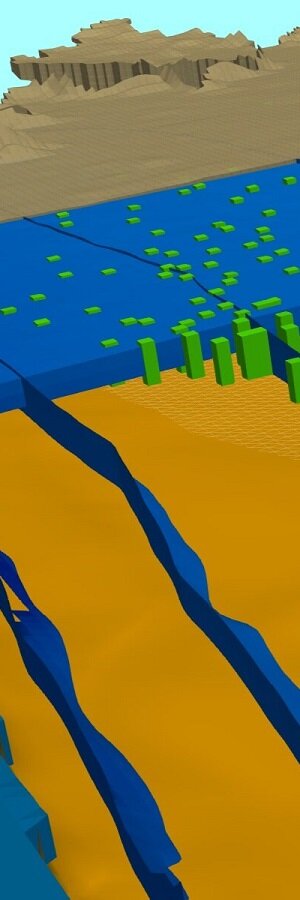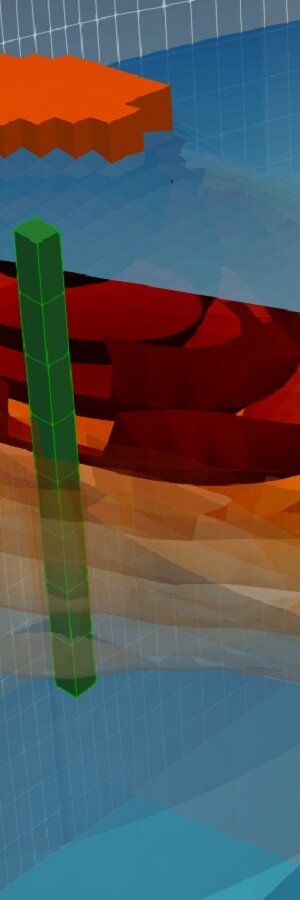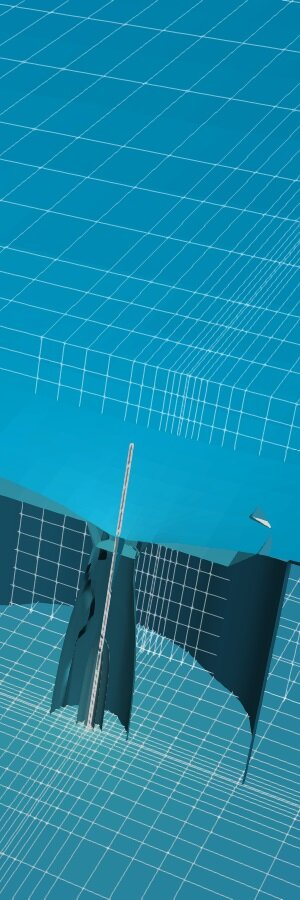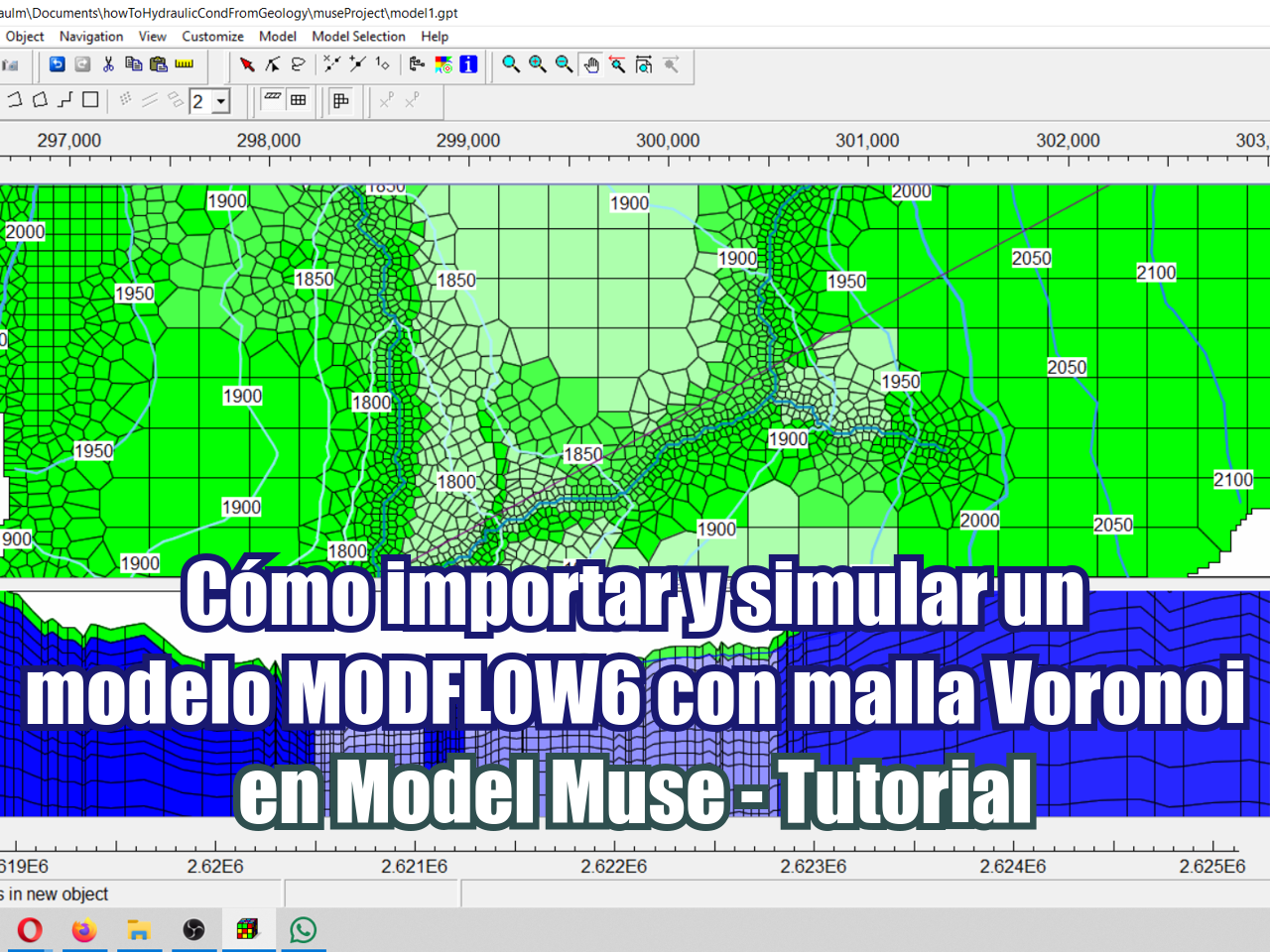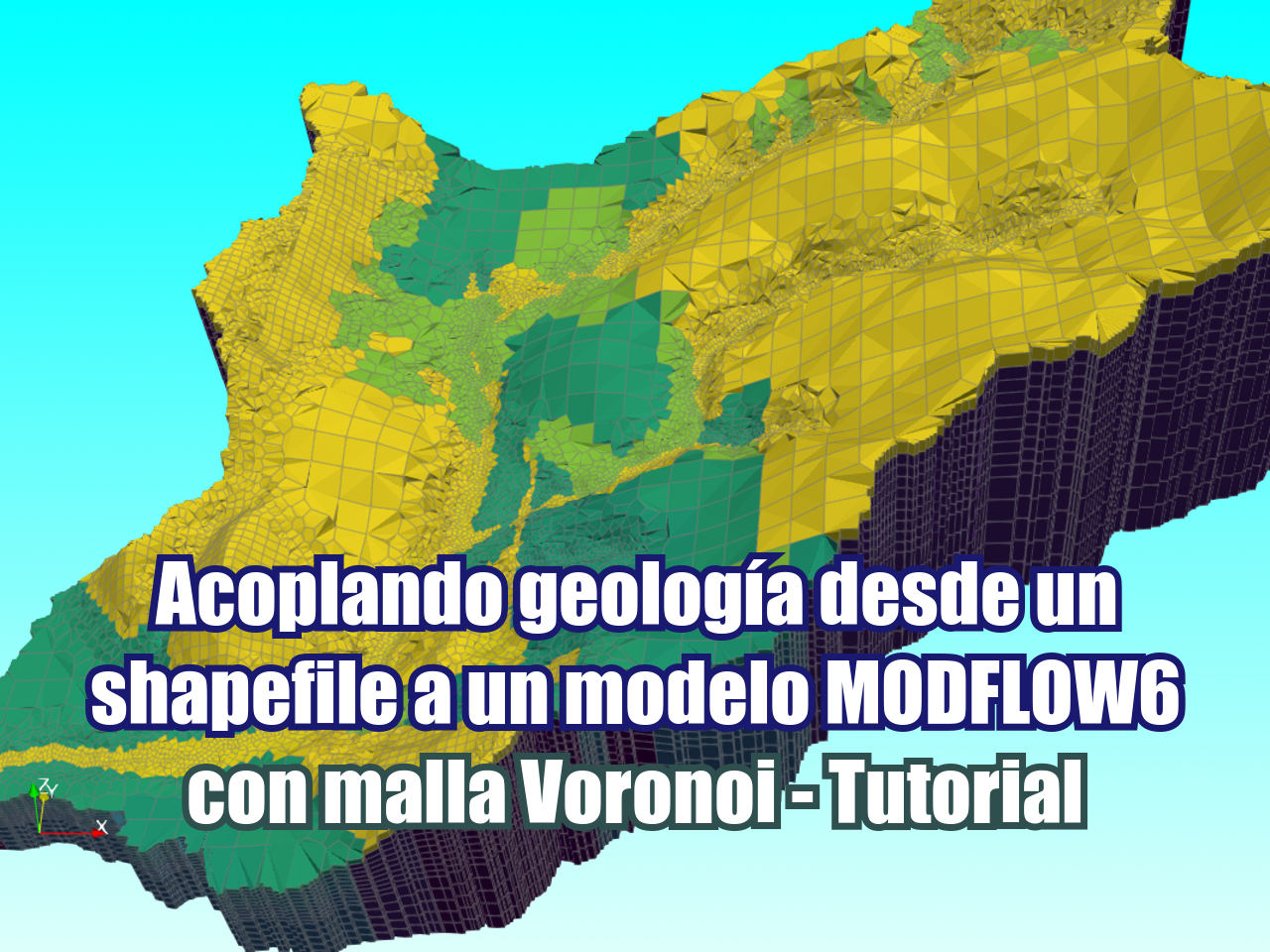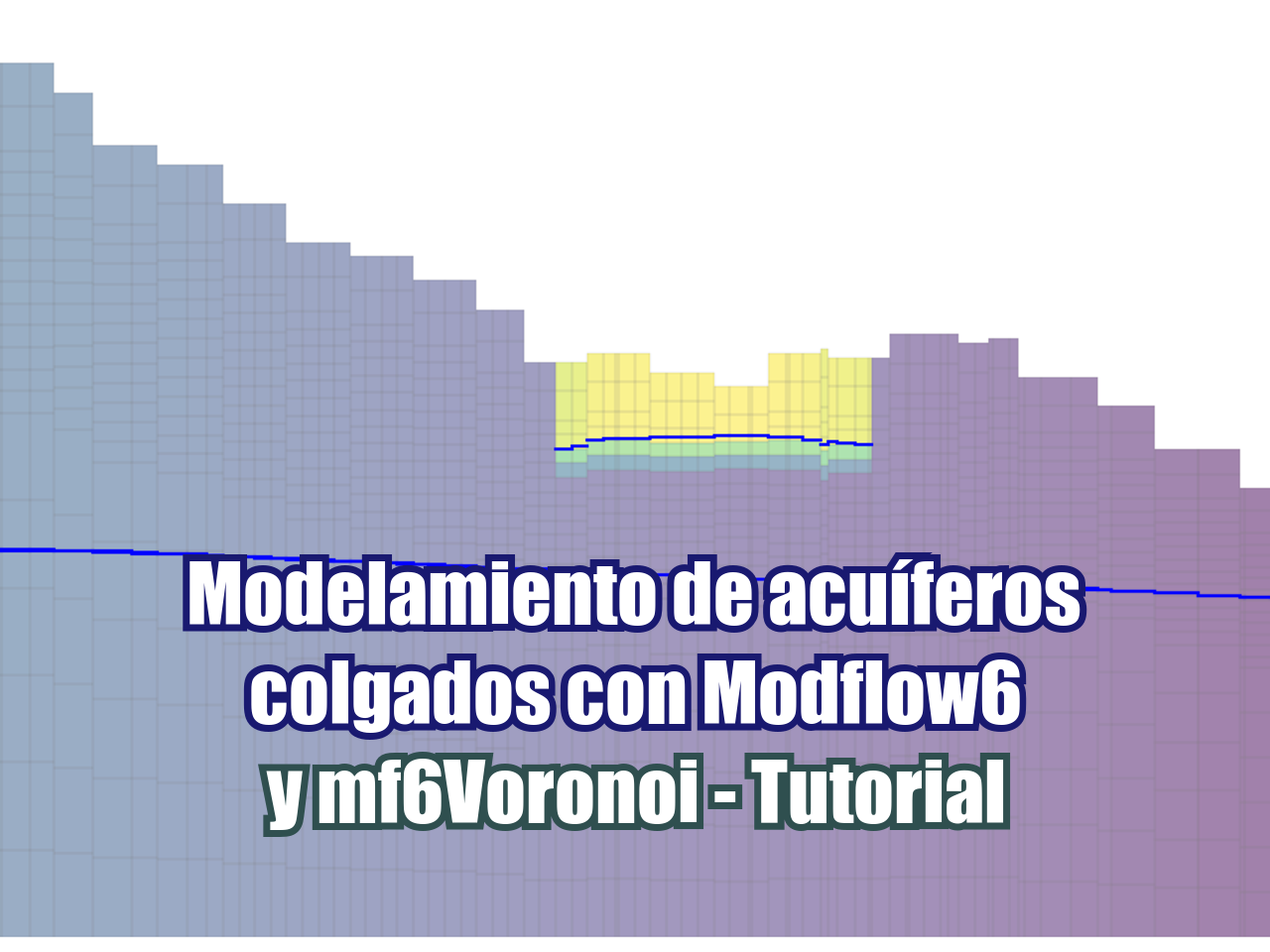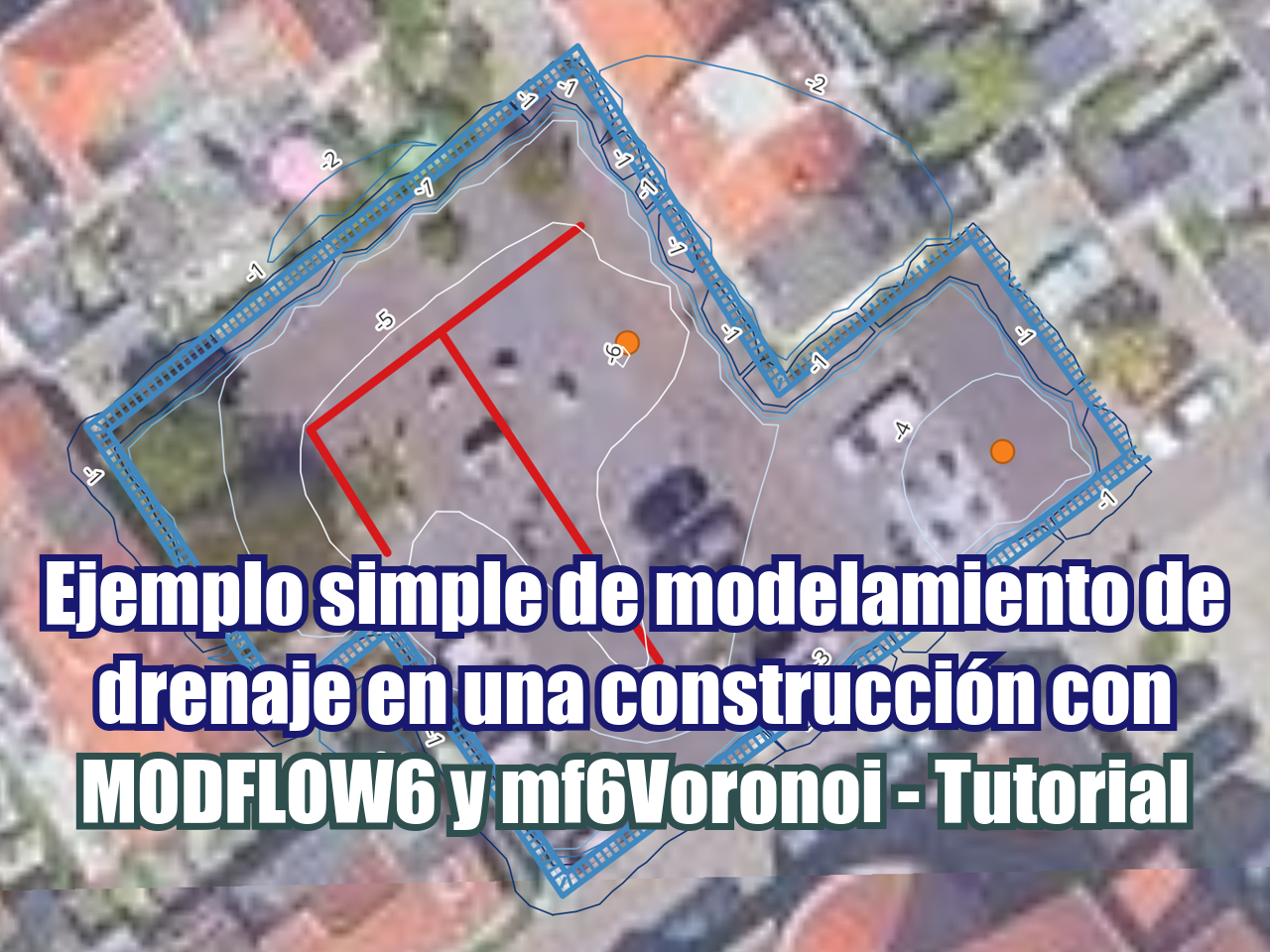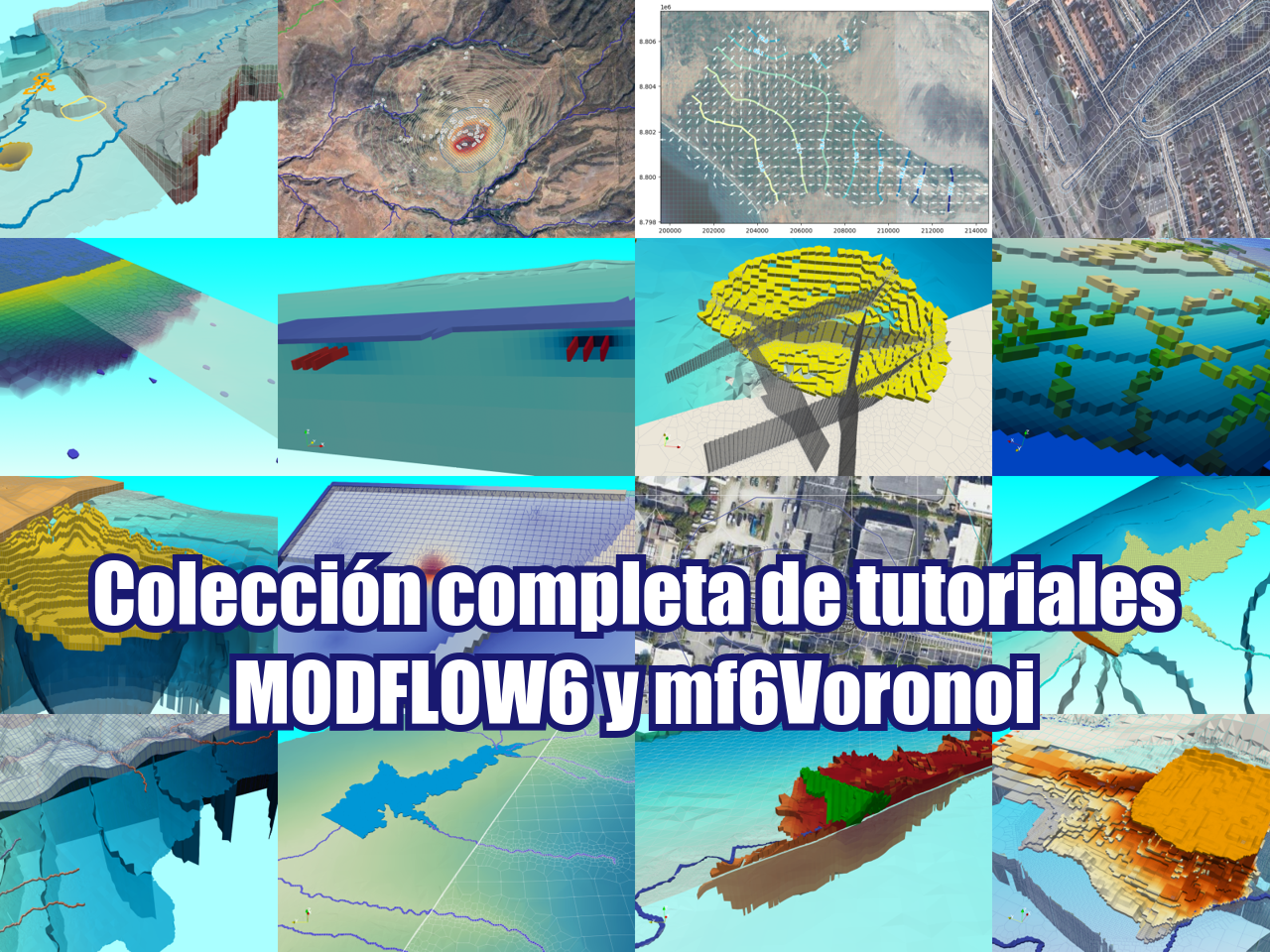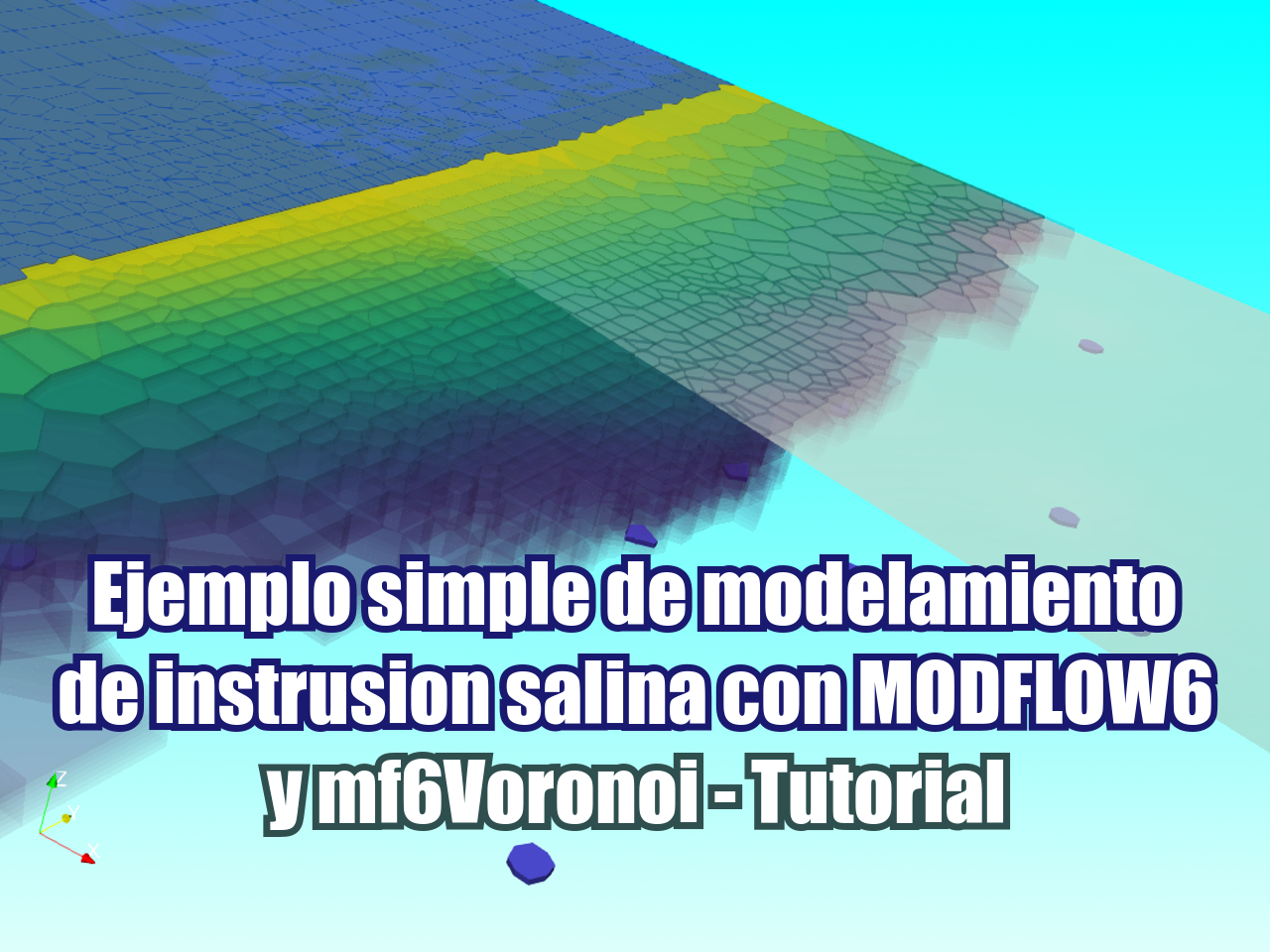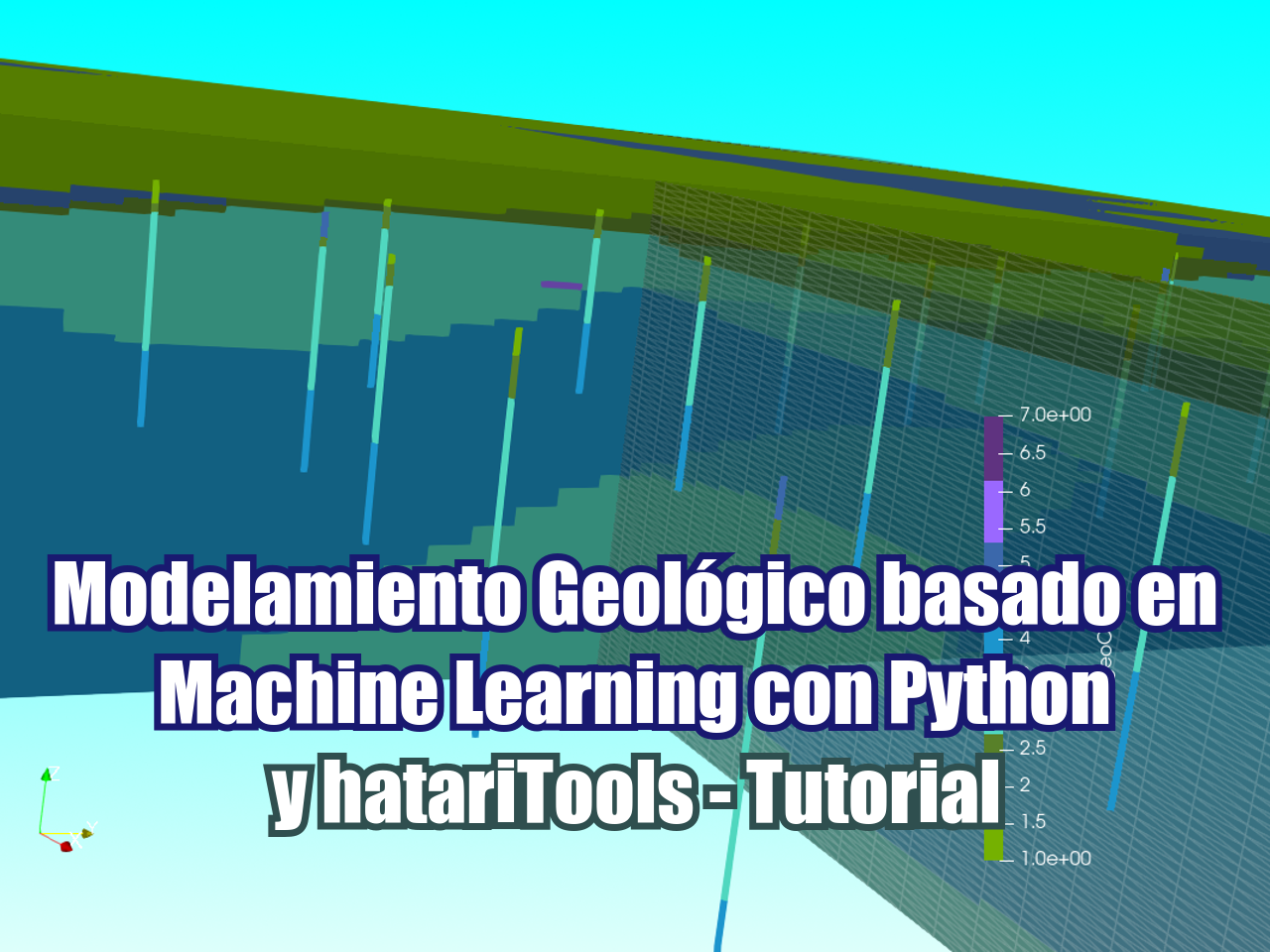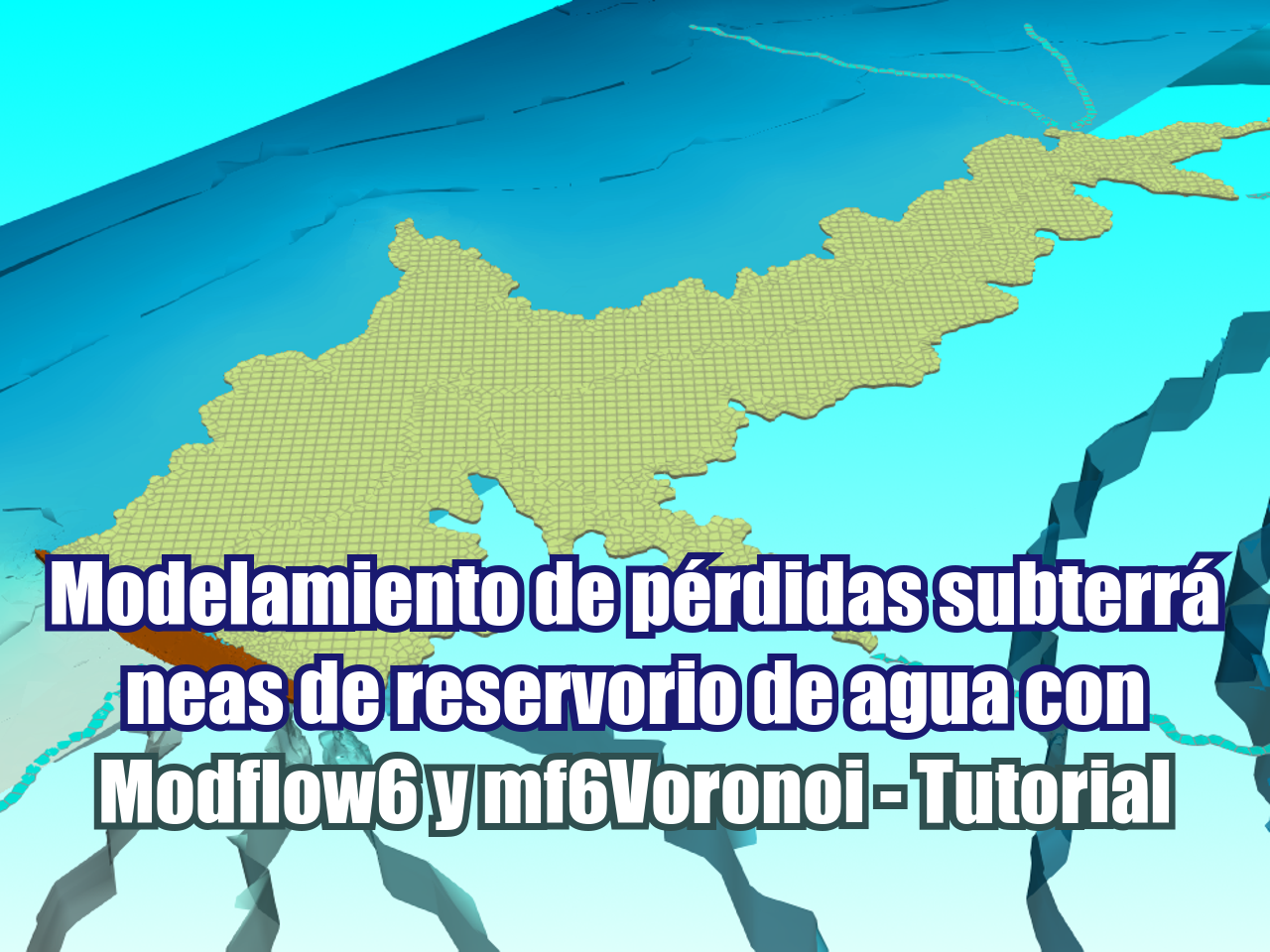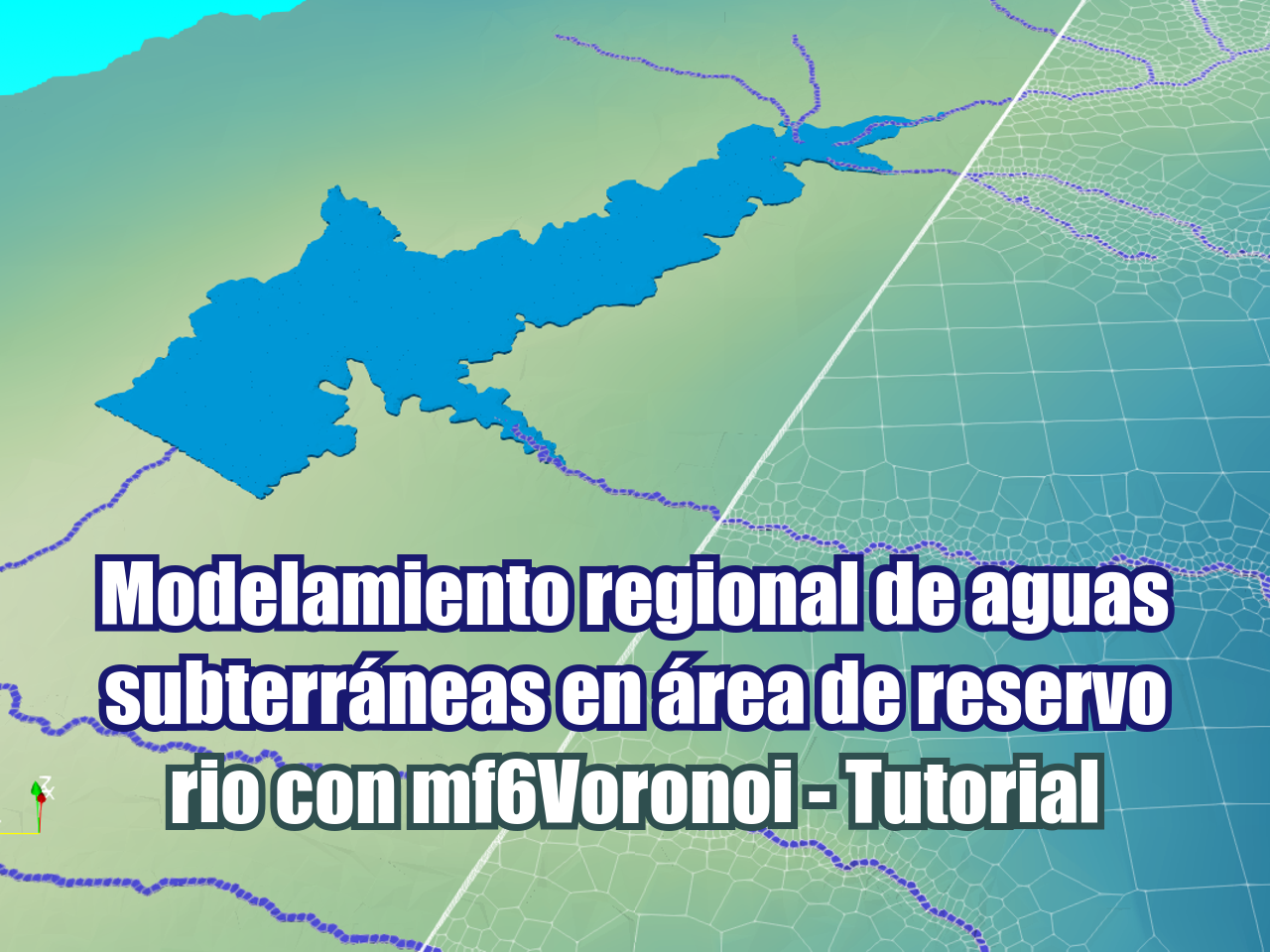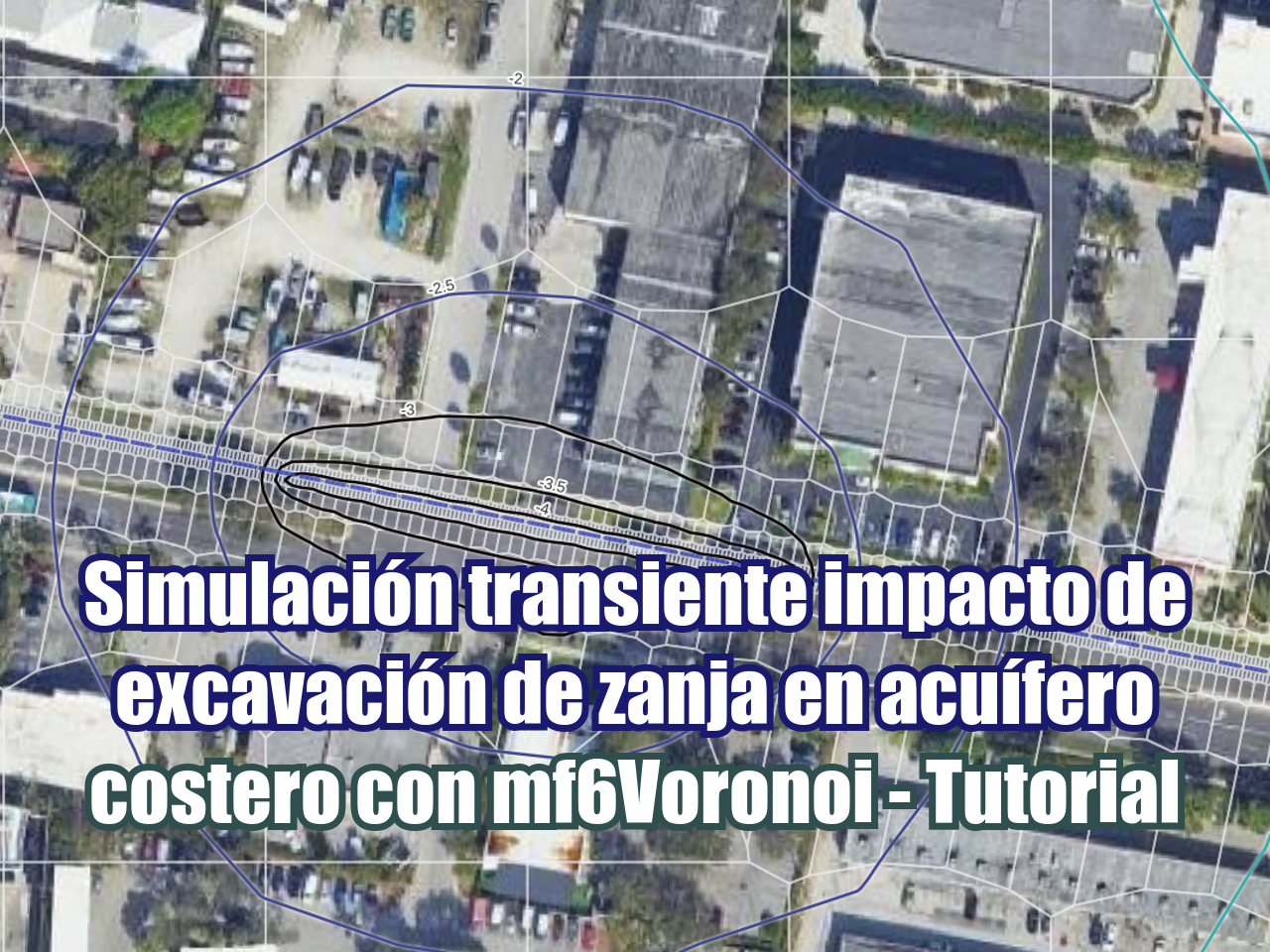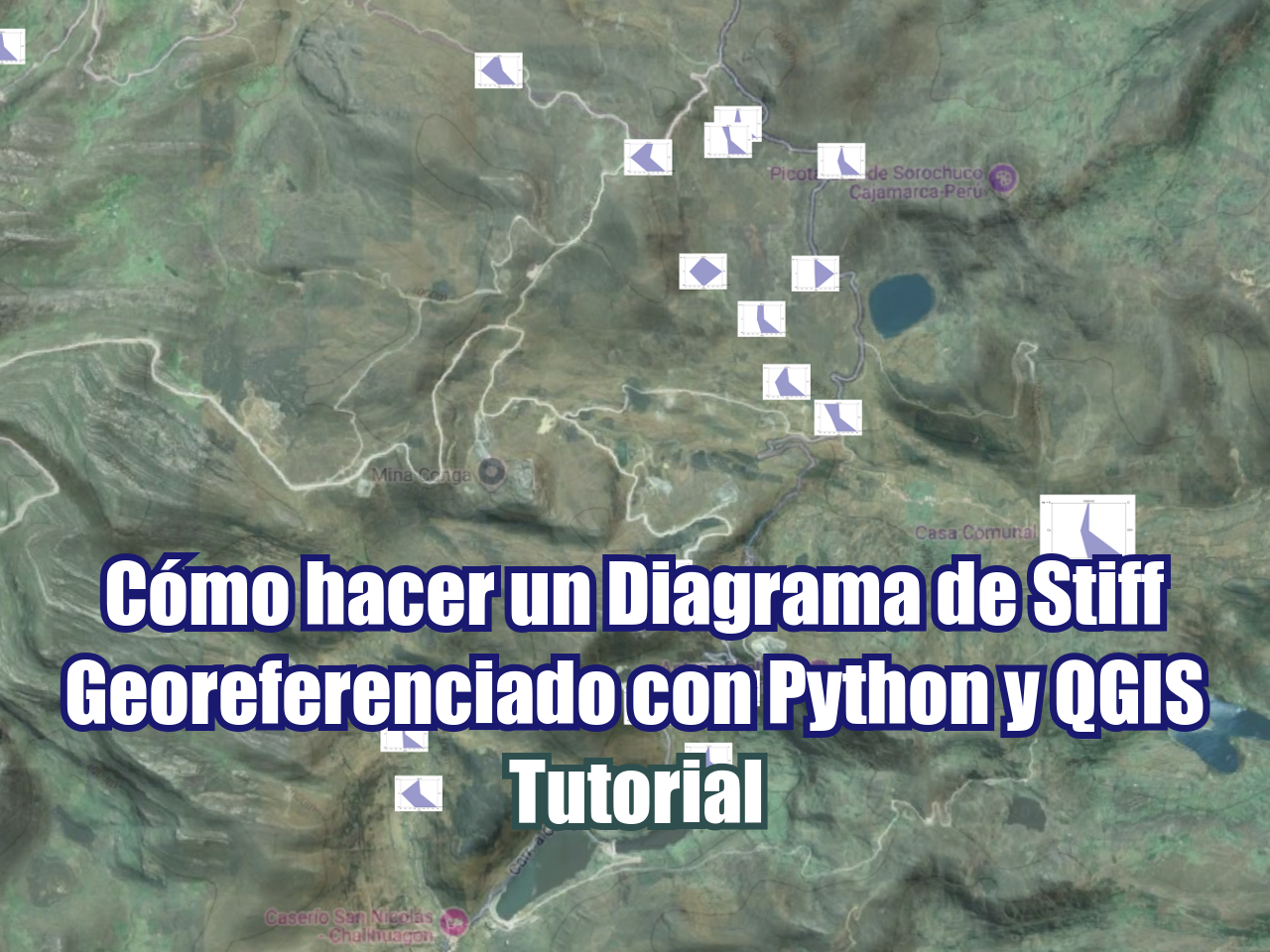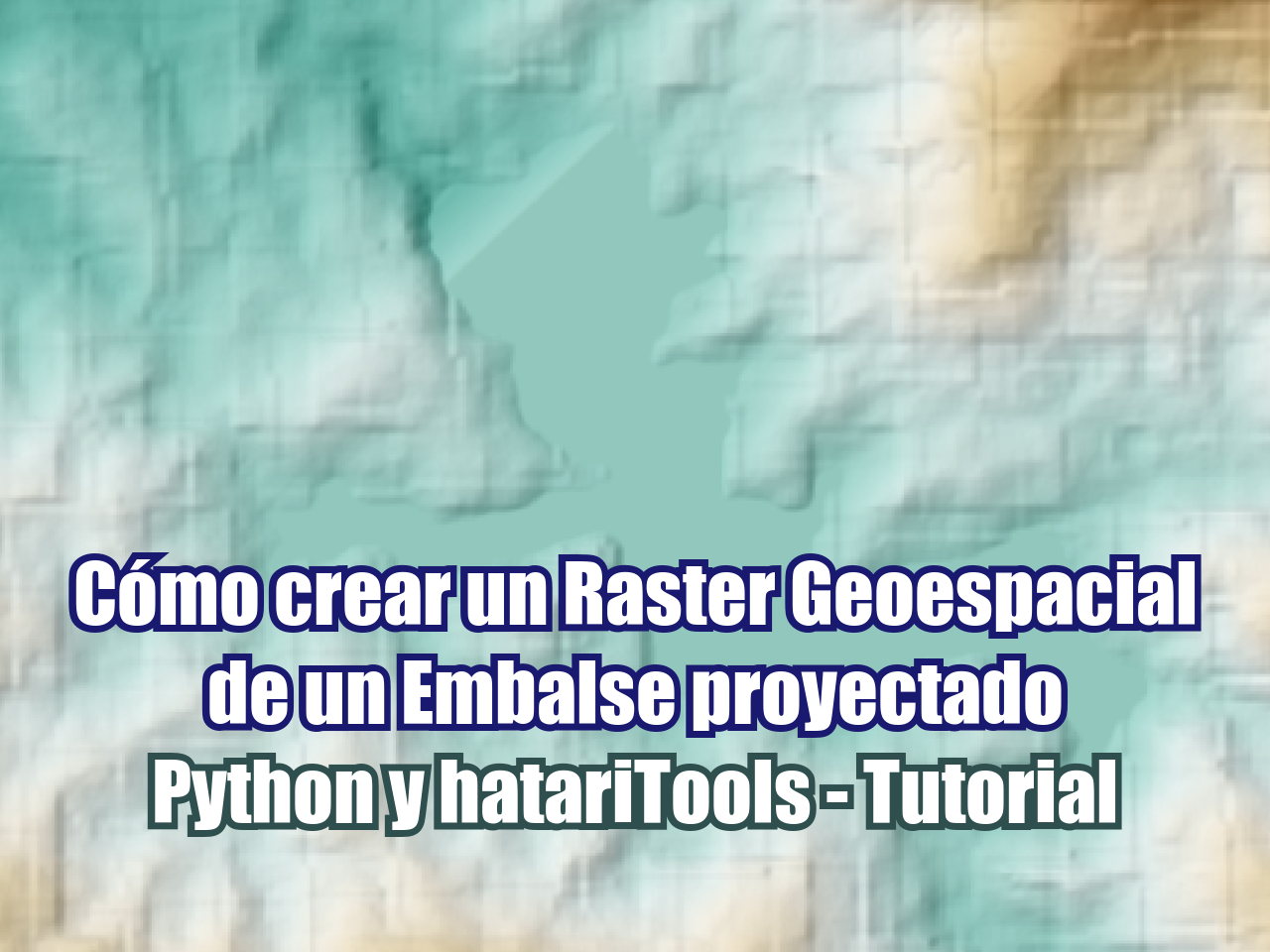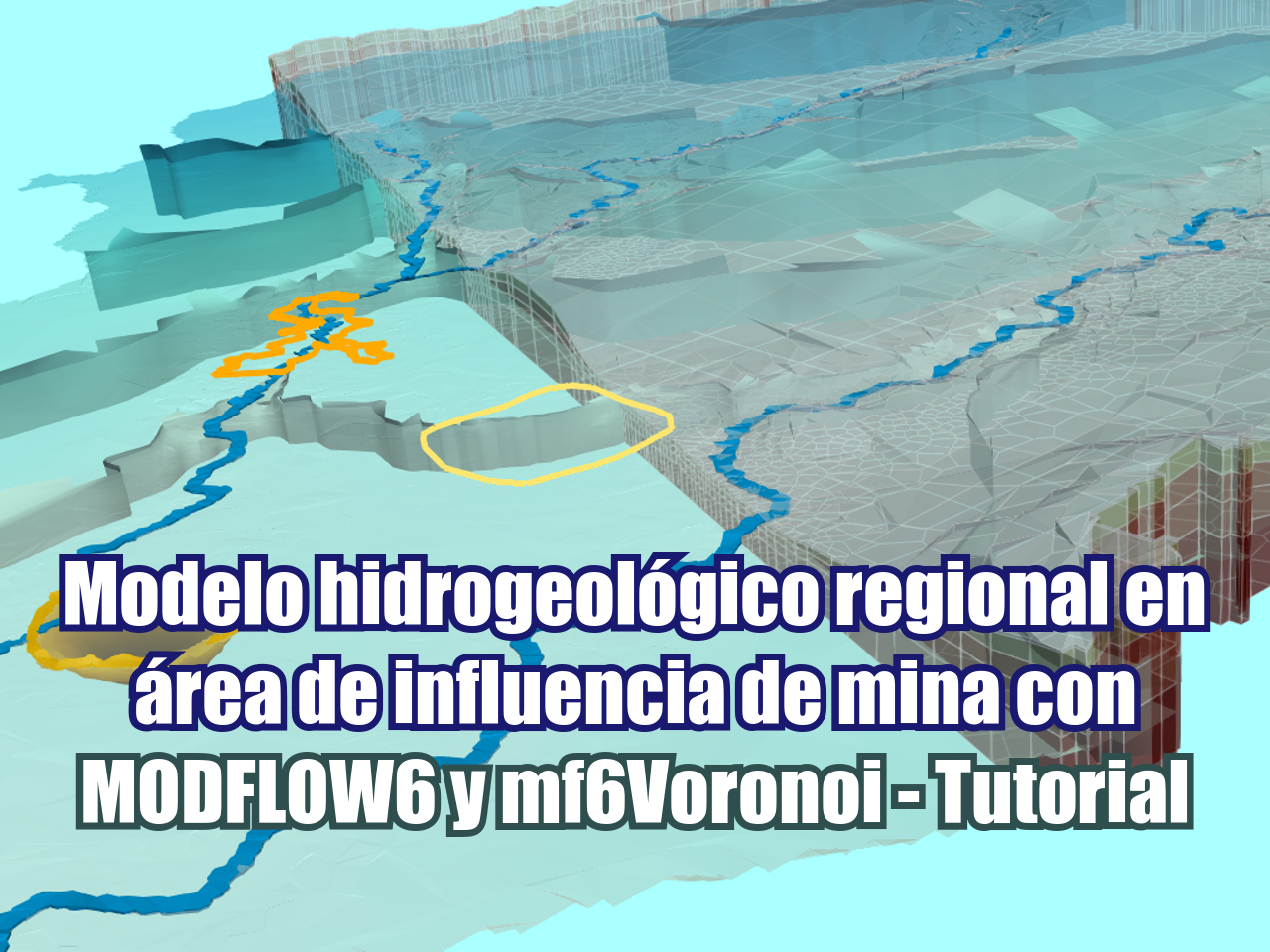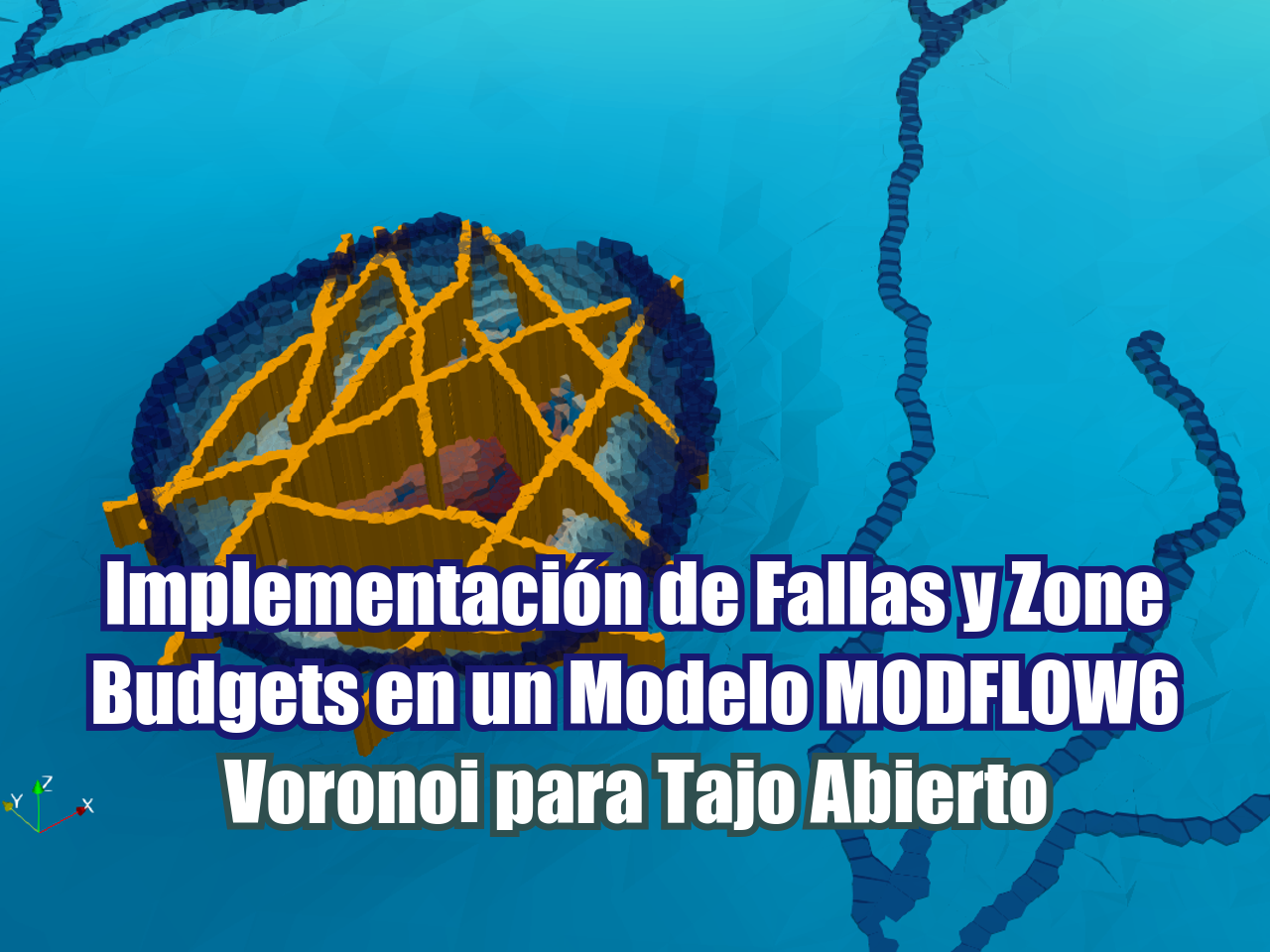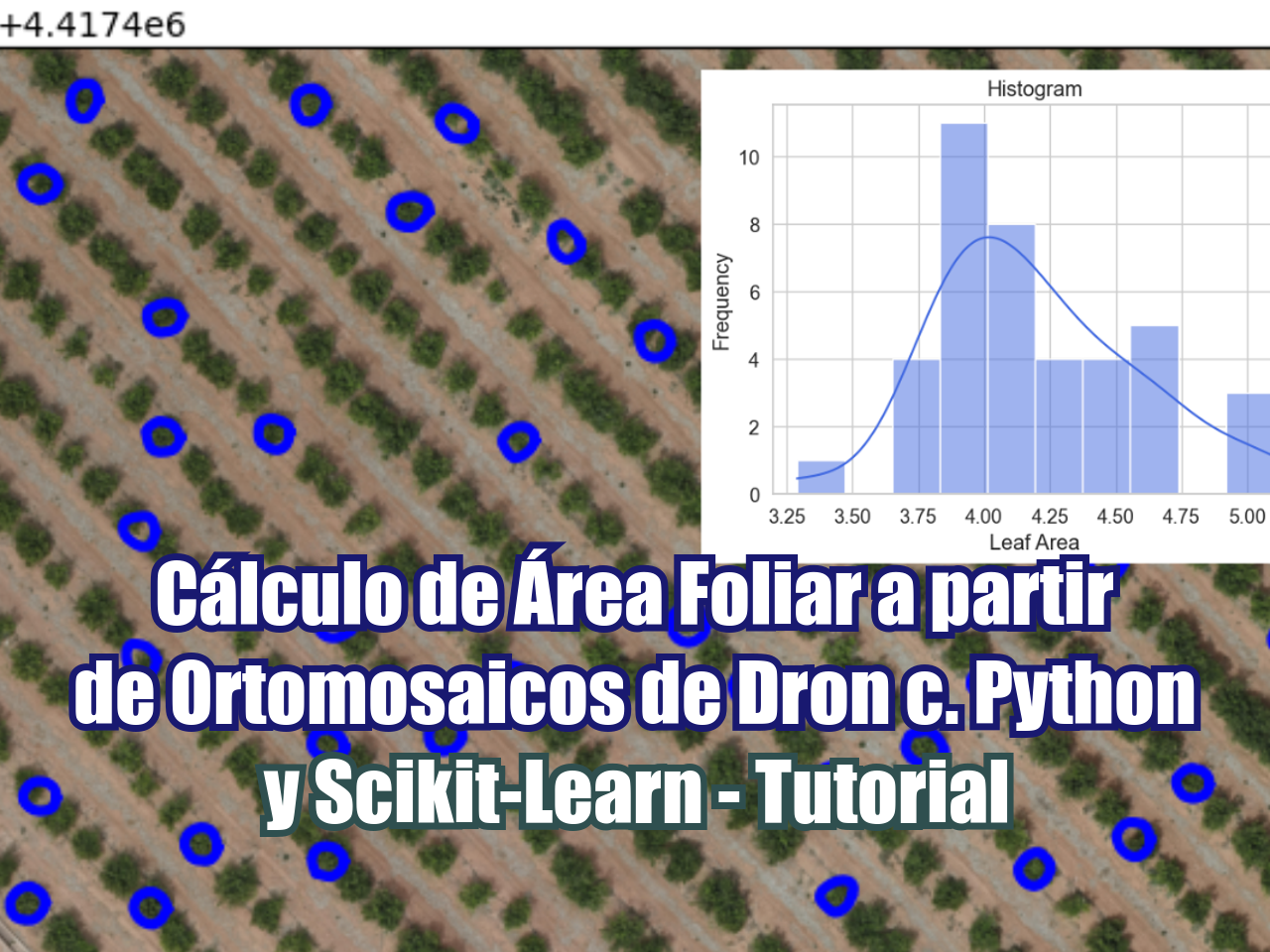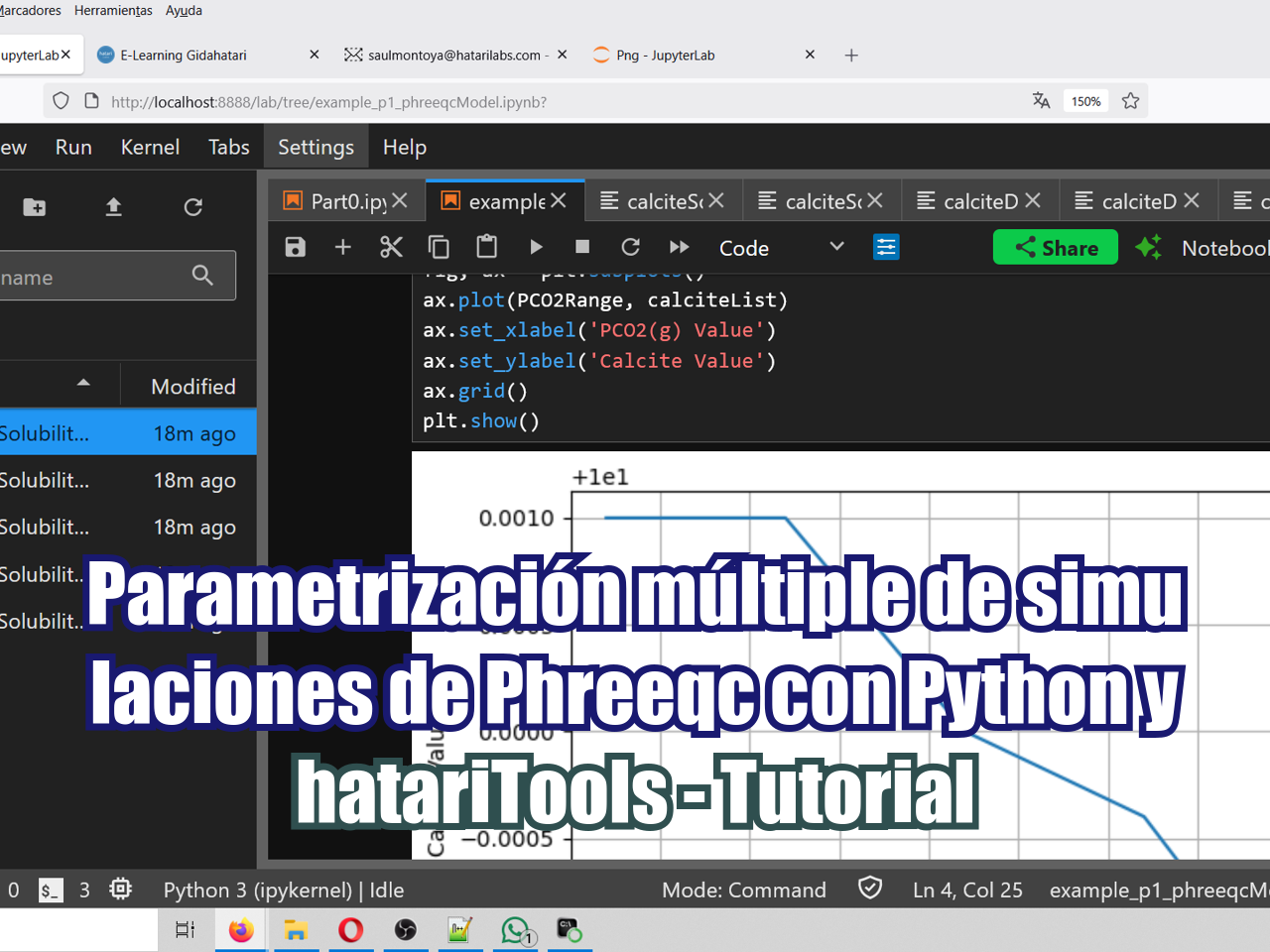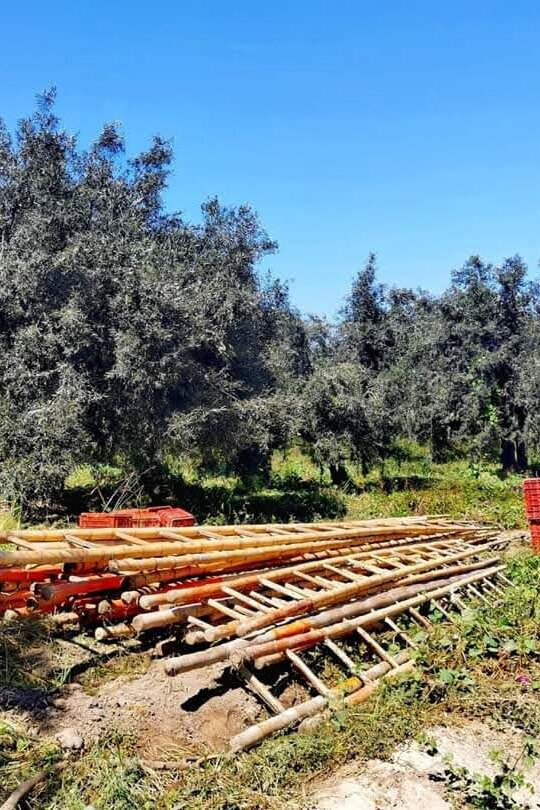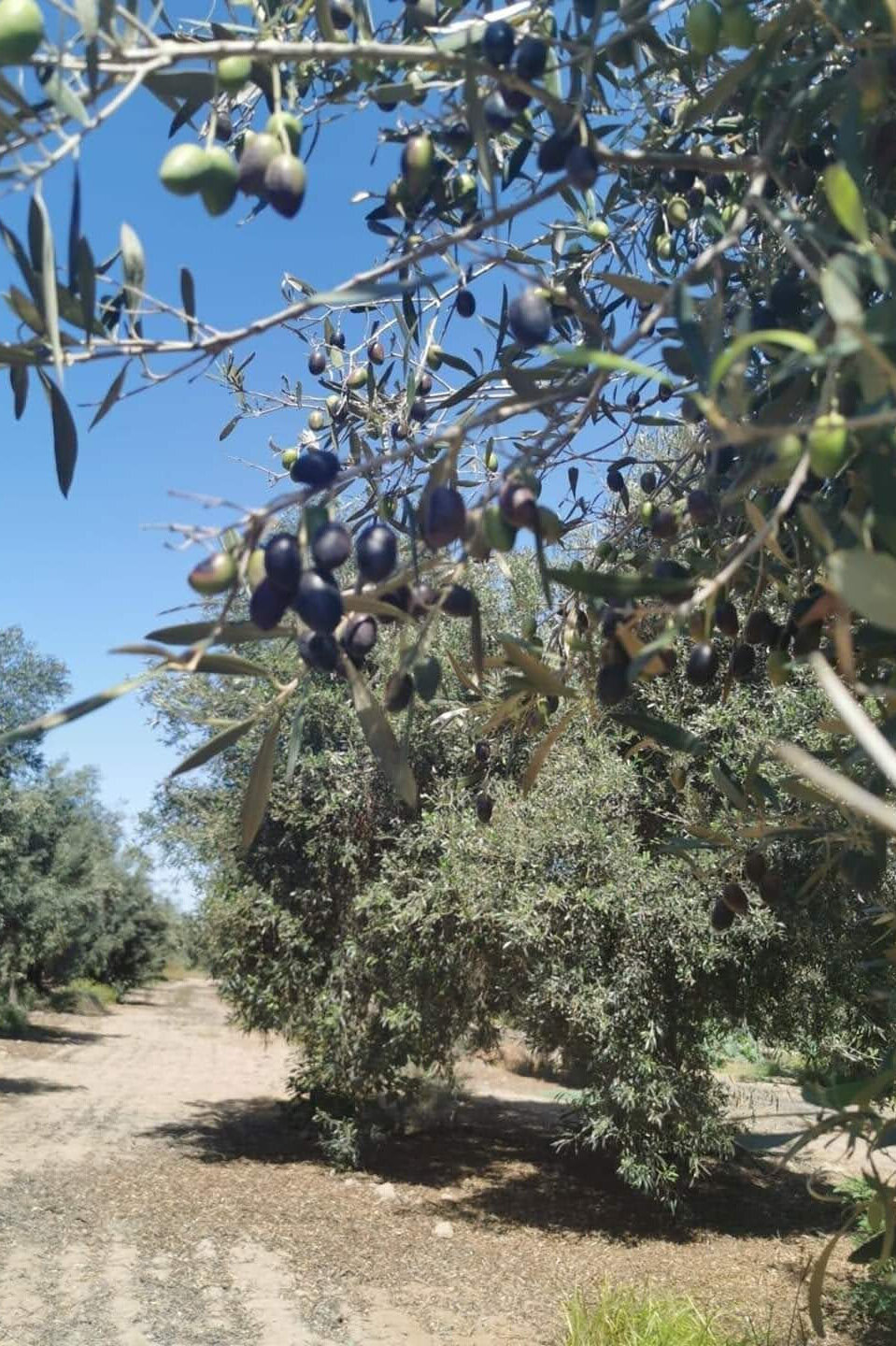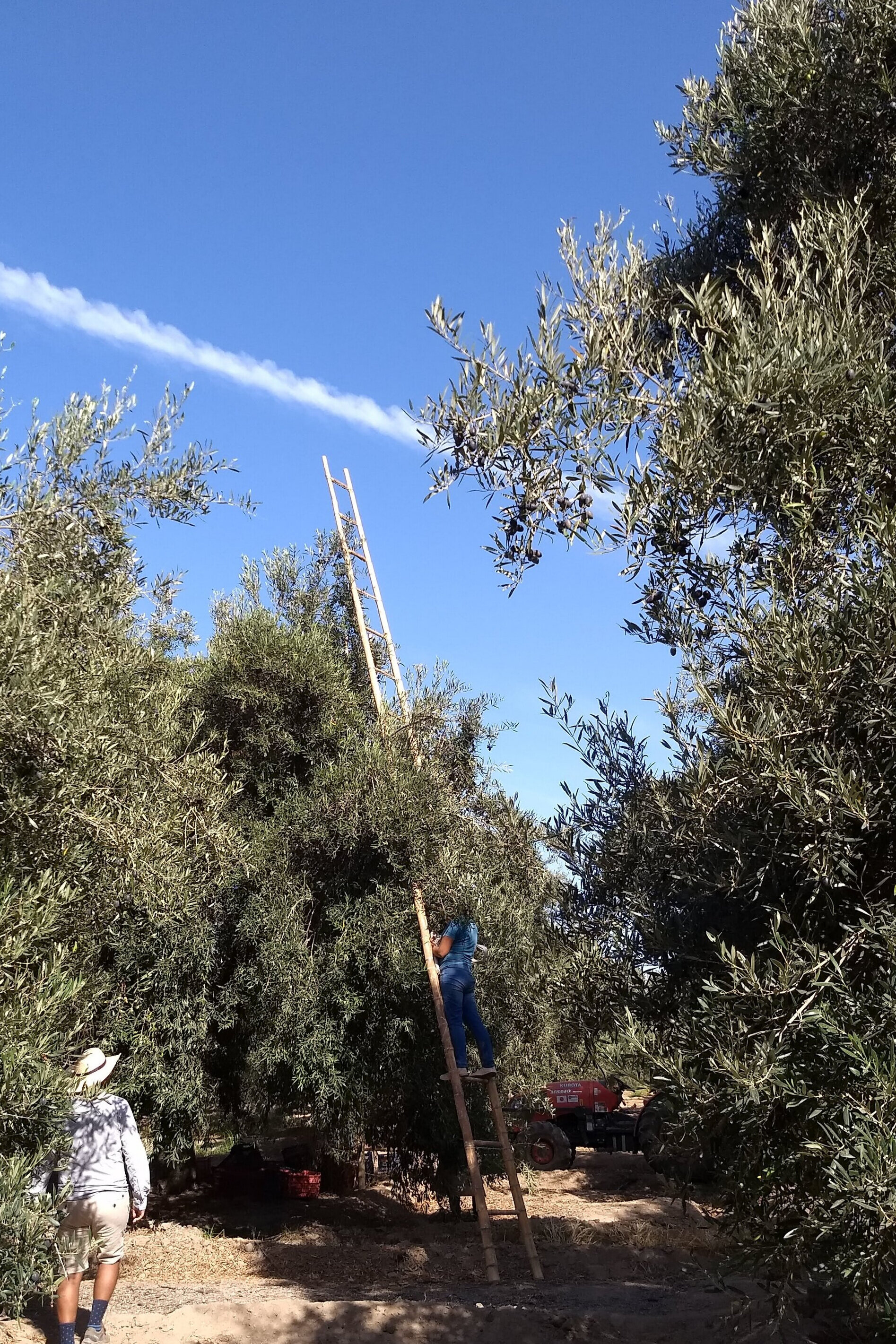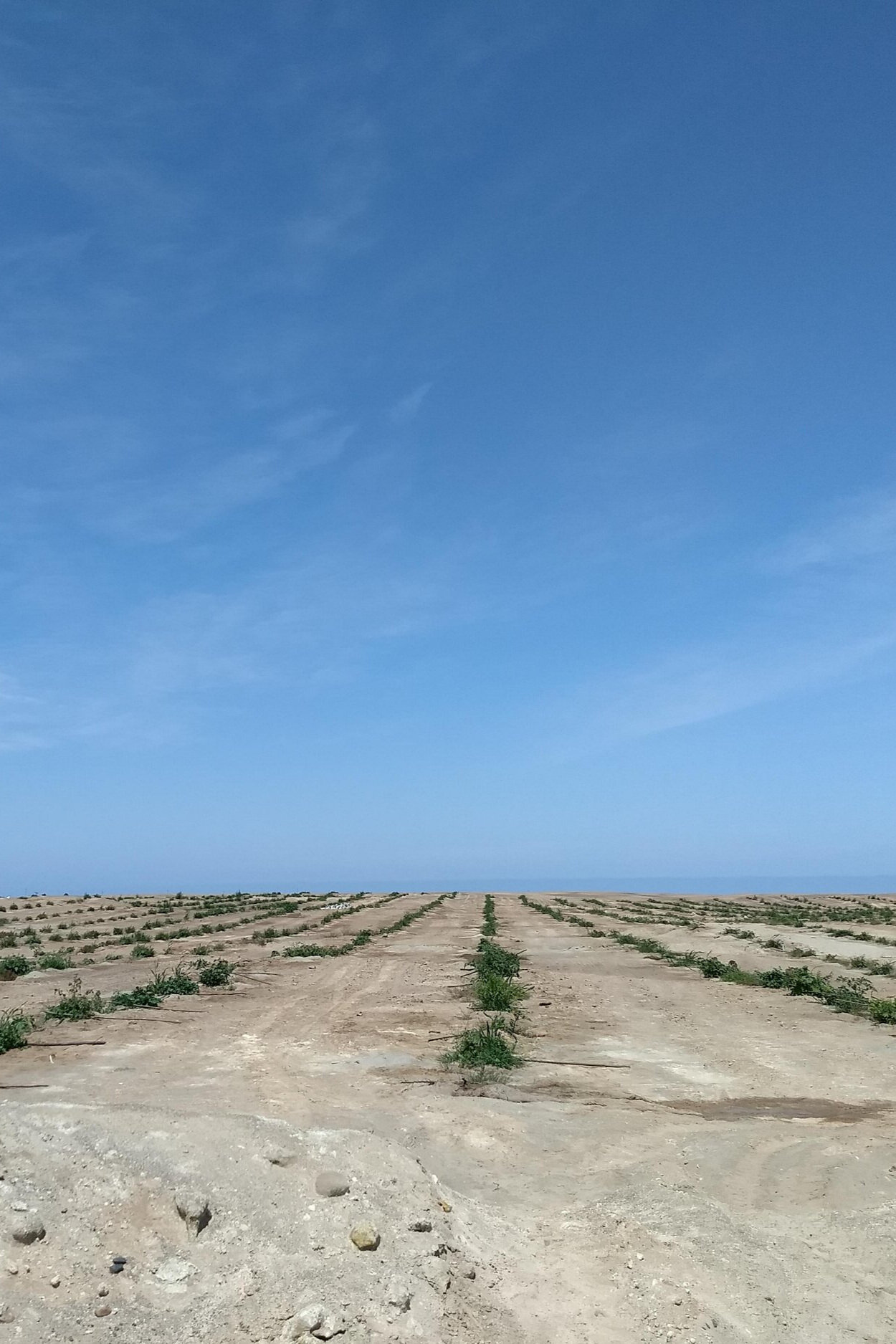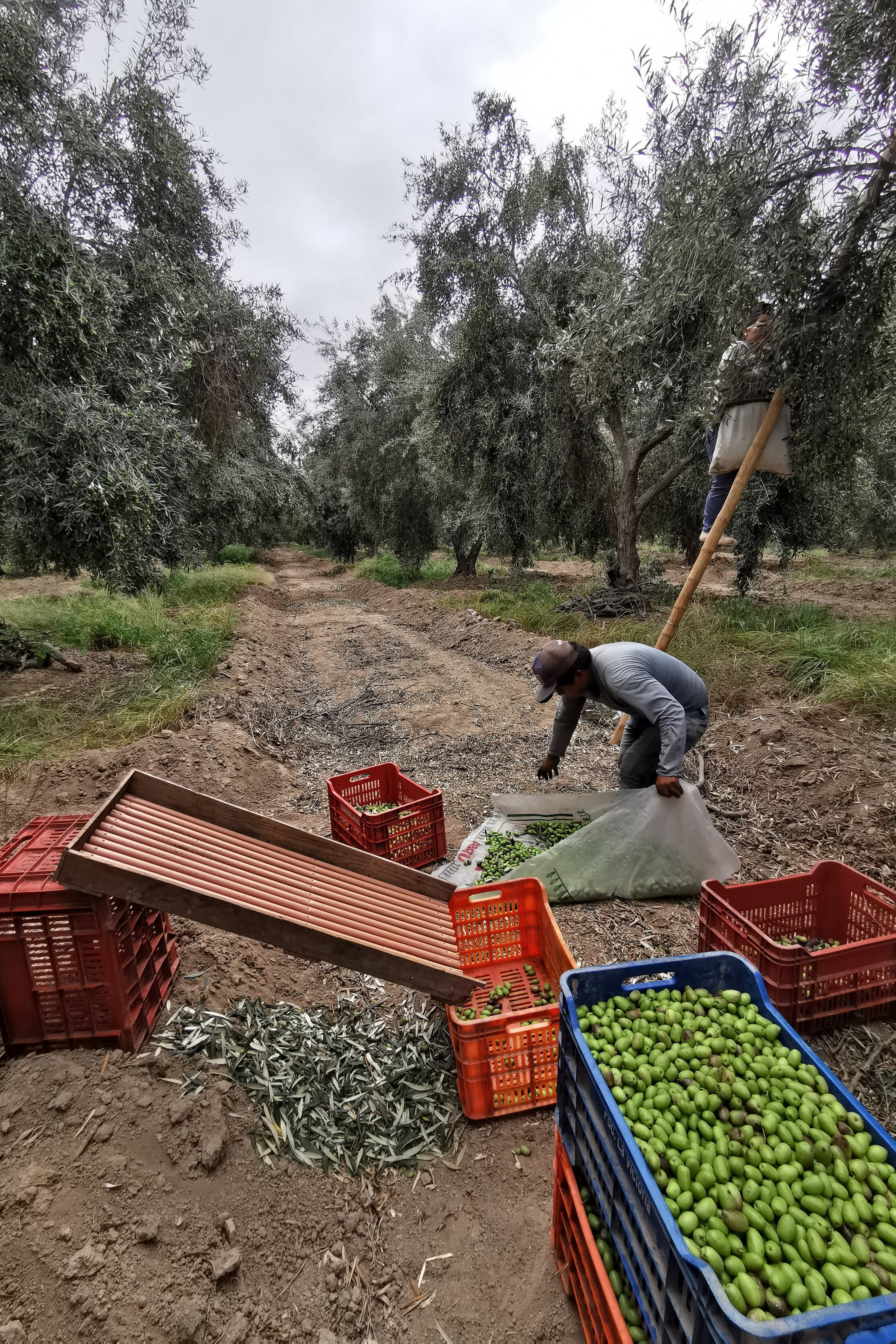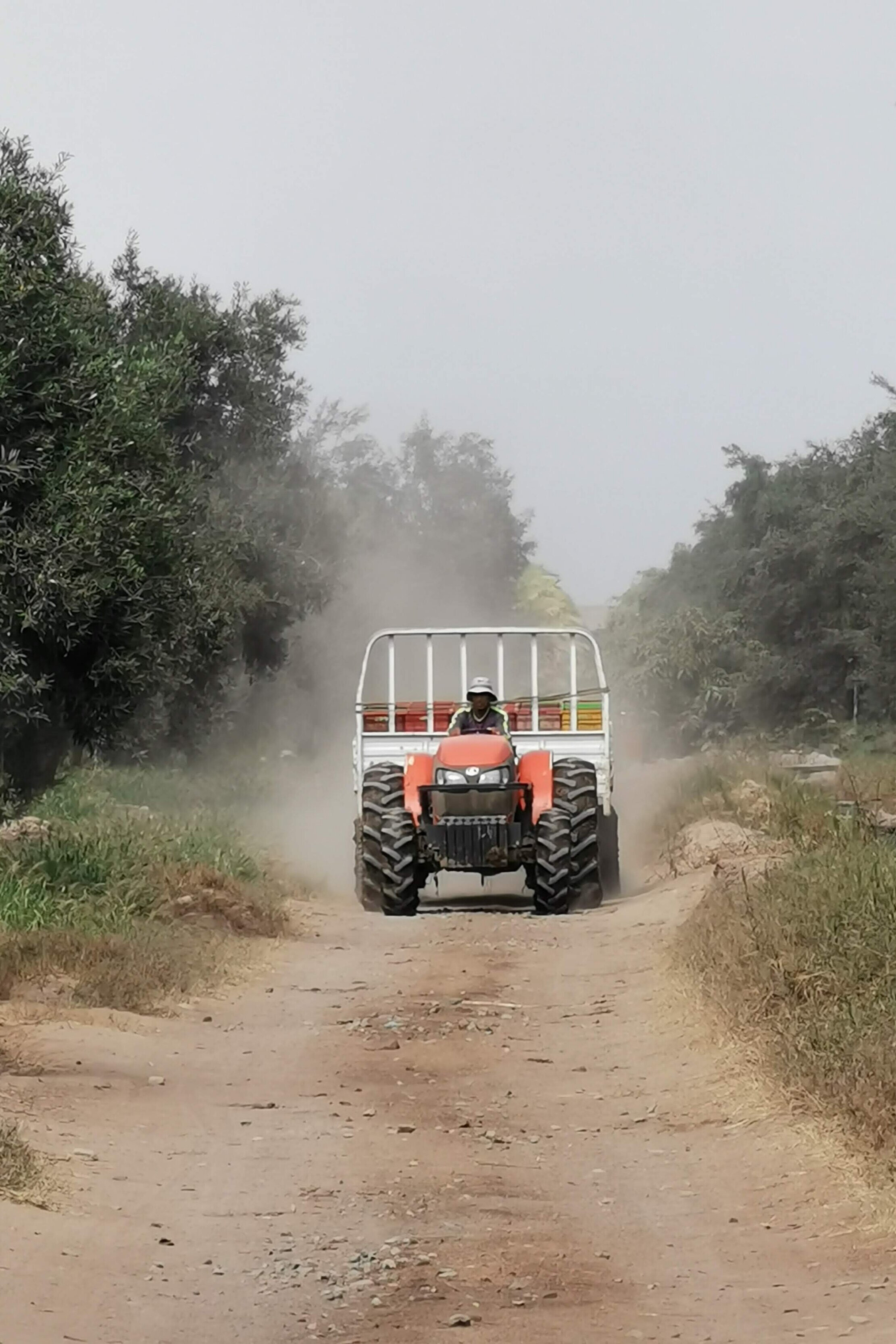Infiltration galleries are a low cost and low maintenance option for domestic water supply. The amount of inflow water and the interaction with the water bodies are main concerns on the evaluation and design of infiltration galleries. We have done an applied case of inflow simulation to infiltration galleries with MODFLOW6 based on Voronoi meshes. The example covers all steps from mesh creation, steady state model construction, simulation of infiltration galleries and the inflow calculation per gallery group. Finally a 3D representation of the model geometry, boundary conditions and head distribution is performed on Paraview.
Tutorial
Código
from mf6Voronoi.utils import listTemplates, copyTemplate#listTemplates()copyTemplate('generateVoronoi','galeria')copyTemplate('modelCreation','galeria')copyTemplate('vtkGeneration','galeria')Part 1 : Voronoi mesh generation
import warnings ## Org
warnings.filterwarnings('ignore') ## Org
import os, sys ## Org
import geopandas as gpd ## Org
from mf6Voronoi.geoVoronoi import createVoronoi ## Org
from mf6Voronoi.meshProperties import meshShape ## Org
from mf6Voronoi.utils import initiateOutputFolder, getVoronoiAsShp ## Org#Create mesh object specifying the coarse mesh and the multiplier
vorMesh = createVoronoi(meshName='infiltrationGalleries',maxRef = 25, multiplier=1.5) ## Org
#Open limit layers and refinement definition layers
vorMesh.addLimit('basin','../shp/modelLimit.shp') ## Org
vorMesh.addLayer('galleries','../shp/infiltrationGalleries.shp',1) ## Org
vorMesh.addLayer('river','../shp/river.shp',5) ## Org
vorMesh.addLayer('ghb','../shp/regionalFlow.shp',10) ## Org#Generate point pair array
vorMesh.generateOrgDistVertices() ## Org
#Generate the point cloud and voronoi
vorMesh.createPointCloud() ## Org
vorMesh.generateVoronoi() ## OrgFollow us: |
|
|
|
|
|
|
/--------Layer galleries discretization-------/
Progressive cell size list: [1, 2.5, 4.75, 8.125, 13.1875, 20.78125] m.
/--------Layer river discretization-------/
Progressive cell size list: [5, 12.5, 23.75] m.
/--------Layer ghb discretization-------/
Progressive cell size list: [10, 25.0] m.
/----Sumary of points for voronoi meshing----/
Distributed points from layers: 3
Points from layer buffers: 2291
Points from max refinement areas: 312
Points from min refinement areas: 1042
Total points inside the limit: 4140
/--------------------------------------------/
Time required for point generation: 0.77 seconds
/----Generation of the voronoi mesh----/
Time required for voronoi generation: 0.57 seconds#Uncomment the next two cells if you have strong differences on discretization or you have encounter an FORTRAN error while running MODFLOW6vorMesh.checkVoronoiQuality(threshold=0.01)/----Performing quality verification of voronoi mesh----/
Short side on polygon: 4139 with length = 0.00080
Short side on polygon: 4139 with length = 0.00080
Short side on polygon: 4139 with length = 0.00316
Short side on polygon: 4139 with length = 0.00316
Short side on polygon: 4139 with length = 0.00985
Short side on polygon: 4139 with length = 0.00985
Short side on polygon: 4139 with length = 0.00685
Short side on polygon: 4139 with length = 0.00685
Short side on polygon: 4139 with length = 0.00610
Short side on polygon: 4139 with length = 0.00610
Short side on polygon: 4139 with length = 0.00492
Short side on polygon: 4139 with length = 0.00492
Short side on polygon: 4139 with length = 0.00440
Short side on polygon: 4139 with length = 0.00440
Short side on polygon: 4139 with length = 0.00440
Short side on polygon: 4139 with length = 0.00440vorMesh.fixVoronoiShortSides()
vorMesh.generateVoronoi()
vorMesh.checkVoronoiQuality(threshold=0.01)/----Generation of the voronoi mesh----/
Time required for voronoi generation: 0.49 seconds
/----Performing quality verification of voronoi mesh----/
Your mesh has no edges shorter than your threshold#Export generated voronoi mesh
initiateOutputFolder('../output') ## Org
getVoronoiAsShp(vorMesh.modelDis, shapePath='../output/'+vorMesh.modelDis['meshName']+'.shp') ## OrgThe output folder ../output exists and has been cleared
/----Generation of the voronoi shapefile----/
Time required for voronoi shapefile: 0.93 seconds# Show the resulting voronoi mesh
#open the mesh file
mesh=gpd.read_file('../output/'+vorMesh.modelDis['meshName']+'.shp') ## Org
#plot the mesh
mesh.plot(figsize=(35,25), fc='crimson', alpha=0.3, ec='teal') ## OrgPart 2 generate disv properties
# open the mesh file
mesh=meshShape('../output/'+vorMesh.modelDis['meshName']+'.shp')# get the list of vertices and cell2d data
gridprops=mesh.get_gridprops_disv() ## OrgCreating a unique list of vertices [[x1,y1],[x2,y2],...]
100%|███████████████████████████████████████████████████████████████████████████| 4148/4148 [00:00<00:00, 18028.78it/s]
Extracting cell2d data and grid index
100%|████████████████████████████████████████████████████████████████████████████| 4148/4148 [00:01<00:00, 2972.32it/s]#create folder
initiateOutputFolder('../json')
#export disv
mesh.save_properties('../json/disvDict.json')The output folder ../json exists and has been clearedPart 2a: generate disv properties
import sys, json, os ## Org
import rasterio, flopy ## Org
import numpy as np ## Org
import matplotlib.pyplot as plt ## Org
import geopandas as gpd ## Org
from mf6Voronoi.meshProperties import meshShape ## Org
from shapely.geometry import MultiLineString ## Org
from shapely.geometry import MultiLineString, MultiPolygon ## <==== updated
from mf6Voronoi.tools.cellWork import getLayCellElevTupleFromRaster, getLayCellElevTupleFromElev ## <==== updated
from mf6Voronoi.tools.graphs2d import generateRasterFromArray ## <==== updated# open the json file
with open('../json/disvDict.json') as file: ## Org
gridProps = json.load(file) ## Orgcell2d = gridProps['cell2d'] #cellid, cell centroid xy, vertex number and vertex id list
vertices = gridProps['vertices'] #vertex id and xy coordinates
ncpl = gridProps['ncpl'] #number of cells per layer
nvert = gridProps['nvert'] #number of verts
centroids=gridProps['centroids'] #cell centroids xyPart 2b: Model construction and simulation
#Extract dem values for each centroid of the voronois
src = rasterio.open('../rst/dem44N_v2.tif') ## Org
elevation=[x for x in src.sample(centroids)] ## Orgnlay = 10 ## Org
mtop=np.array([elev[0] for i,elev in enumerate(elevation)]) ## Org
zbot=np.zeros((nlay,ncpl)) ## Org
AcuifInf_Bottom = 1262 ## Org
zbot[0,] = AcuifInf_Bottom + (0.97 * (mtop - AcuifInf_Bottom)) ## Org
zbot[1,] = AcuifInf_Bottom + (0.94 * (mtop - AcuifInf_Bottom)) ## Org
zbot[2,] = AcuifInf_Bottom + (0.91 * (mtop - AcuifInf_Bottom)) ## Org
zbot[3,] = AcuifInf_Bottom + (0.88 * (mtop - AcuifInf_Bottom)) ## Org
zbot[4,] = AcuifInf_Bottom + (0.82 * (mtop - AcuifInf_Bottom)) ## Org
zbot[5,] = AcuifInf_Bottom + (0.75 * (mtop - AcuifInf_Bottom)) ## Org
zbot[6,] = AcuifInf_Bottom + (0.65 * (mtop - AcuifInf_Bottom)) ## Org
zbot[7,] = AcuifInf_Bottom + (0.45 * (mtop - AcuifInf_Bottom)) ## Org
zbot[8,] = AcuifInf_Bottom + (0.15 * (mtop - AcuifInf_Bottom)) ## Org
zbot[9,] = AcuifInf_Bottom ## OrgCreate simulation and model
# create simulation
simName = 'mf6Sim' ## Org
modelName = 'mf6Model' ## Org
modelWs = '../modelFiles' ## Org
sim = flopy.mf6.MFSimulation(sim_name=modelName, version='mf6', ## Org
exe_name='../bin/mf6.exe', ## Org
sim_ws=modelWs) ## Org# create tdis package
tdis_rc = [(1000.0, 1, 1.0)] ## Org
tdis = flopy.mf6.ModflowTdis(sim, pname='tdis', time_units='SECONDS', ## Org
perioddata=tdis_rc) ## Org# create gwf model
gwf = flopy.mf6.ModflowGwf(sim, ## Org
modelname=modelName, ## Org
save_flows=True, ## Org
newtonoptions="NEWTON UNDER_RELAXATION") ## Org# create iterative model solution and register the gwf model with it
ims = flopy.mf6.ModflowIms(sim, ## Org
complexity='COMPLEX', ## Org
outer_maximum=150, ## Org
inner_maximum=30, ## Org
linear_acceleration='BICGSTAB') ## Org
sim.register_ims_package(ims,[modelName]) ## Org# disv
disv = flopy.mf6.ModflowGwfdisv(gwf, nlay=nlay, ncpl=ncpl, ## Org
top=mtop, botm=zbot, ## Org
nvert=nvert, vertices=vertices, ## Org
cell2d=cell2d) ## Org# initial conditions
ic = flopy.mf6.ModflowGwfic(gwf, strt=np.stack([mtop for i in range(nlay)])) ## OrgKx =[4E-4 for i in range(5)] + [5E-6 for i in range(5)] ## Org
icelltype = [1 for i in range(2)] + [0 for i in range(8)] ## Org
# node property flow
npf = flopy.mf6.ModflowGwfnpf(gwf, ## Org
save_specific_discharge=True, ## Org
icelltype=icelltype, ## Org
k=Kx,
k33=np.array(Kx)/10) ## Org# define storage and transient stress periods
sto = flopy.mf6.ModflowGwfsto(gwf, ## Org
iconvert=1, ## Org
steady_state={ ## Org
0:True, ## Org
} ## Org
) ## OrgWorking with rechage, evapotranspiration
rchr = 0.15/365/86400 ## Org
rch = flopy.mf6.ModflowGwfrcha(gwf, recharge=rchr) ## Org
evtr = 1.2/365/86400 ## Org
evt = flopy.mf6.ModflowGwfevta(gwf,ievt=1,surface=mtop,rate=evtr,depth=1.0) ## OrgDefinition of the intersect object
For the manipulation of spatial data to determine hydraulic parameters or boundary conditions
# Define intersection object
interIx = flopy.utils.gridintersect.GridIntersect(gwf.modelgrid) ## Org#open the river shapefile
rivers =gpd.read_file('../shp/river.shp') ## Org
list_rivers=[] ## Org
for i in range(rivers.shape[0]): ## Org
list_rivers.append(rivers['geometry'].loc[i]) ## Org
riverMls = MultiPolygon(polygons=list_rivers) ## Org
#intersec rivers with our grid
riverCells=interIx.intersect(riverMls).cellids ## Org
riverCells[:10] ## Orgarray([4, 90, 132, 133, 134, 136, 141, 142, 144, 186], dtype=object)#river package
riverSpd = {} ## Org
riverSpd[0] = [] ## Org
for cell in riverCells: ## Org
riverSpd[0].append([(0,cell),mtop[cell]-0.3,0.01,mtop[cell]-0.6]) ## Org
riv = flopy.mf6.ModflowGwfriv(gwf, stress_period_data=riverSpd) ## Org#river plot
riv.plot(mflay=0) ## Org#regional flow package
layCellTupleList, elevList = getLayCellElevTupleFromRaster(gwf,interIx,'../rst/waterTable.tif','../shp/regionalFlow.shp') ## <=== updated
ghbSpd = {} ## Org
ghbSpd[0] = [] ## Org
for index, layCellTuple in enumerate(layCellTupleList): ## <=== updated
ghbSpd[0].append([layCellTuple,elevList[index],0.01]) ## <=== updated
ghbSpd[0][:5] ## <=== updatedThe cell 854 has a elevation of 1294.16 outside the model vertical domain
The cell 889 has a elevation of 1294.20 outside the model vertical domain
The cell 919 has a elevation of 1294.22 outside the model vertical domain
The cell 949 has a elevation of 1294.24 outside the model vertical domain
The cell 1010 has a elevation of 1294.27 outside the model vertical domain
The cell 1059 has a elevation of 1294.31 outside the model vertical domain
The cell 1101 has a elevation of 1294.30 outside the model vertical domain
The cell 1130 has a elevation of 1294.17 outside the model vertical domain
The cell 1217 has a elevation of 1294.12 outside the model vertical domain
The cell 1265 has a elevation of 1294.16 outside the model vertical domain
The cell 1308 has a elevation of 1294.11 outside the model vertical domain
The cell 2682 has a elevation of 1294.09 outside the model vertical domain
The cell 2991 has a elevation of 1294.09 outside the model vertical domain
The cell 3103 has a elevation of 1294.15 outside the model vertical domain
The cell 3141 has a elevation of 1294.16 outside the model vertical domain
The cell 3165 has a elevation of 1294.12 outside the model vertical domain
The cell 3232 has a elevation of 1294.13 outside the model vertical domain
The cell 3260 has a elevation of 1294.18 outside the model vertical domain
The cell 3293 has a elevation of 1294.19 outside the model vertical domain
The cell 3321 has a elevation of 1294.15 outside the model vertical domain
The cell 3377 has a elevation of 1294.16 outside the model vertical domain
[[(2, 83), np.float64(1293.4989), 0.01],
[(2, 135), np.float64(1293.5421), 0.01],
[(2, 188), np.float64(1293.6545), 0.01],
[(2, 217), np.float64(1293.7581), 0.01],
[(2, 247), np.float64(1293.7969), 0.01]]ghb = flopy.mf6.ModflowGwfghb(gwf, stress_period_data=ghbSpd) ## <===== modified
#regional flow plot
ghb.plot(mflay=0, kper=0) ## <===== modified#drain package
drnSpd = {} ## Org
drnSpd[0] = [] ## Org
#gallery1
layCellTupleList = getLayCellElevTupleFromElev(gwf,interIx,1290,'../shp/infiltrationGallery1.shp') ## <=== updated
for index, layCellTuple in enumerate(layCellTupleList): ## <=== updated
drnSpd[0].append([layCellTuple,1290,0.01, 'gallery1']) ## <=== updated
#gallery2
layCellTupleList = getLayCellElevTupleFromElev(gwf,interIx,1290,'../shp/infiltrationGallery2.shp') ## <=== updated
for index, layCellTuple in enumerate(layCellTupleList): ## <=== updated
drnSpd[0].append([layCellTuple,1290,0.01, 'gallery2']) ## <=== updated
drnSpd[0][:5] ## <=== updatedYou have inserted a fixed elevation
You have inserted a fixed elevation
[[(4, 1946), 1290, 0.01, 'gallery1'],
[(4, 1957), 1290, 0.01, 'gallery1'],
[(4, 1970), 1290, 0.01, 'gallery1'],
[(4, 1971), 1290, 0.01, 'gallery1'],
[(4, 1973), 1290, 0.01, 'gallery1']]drn = flopy.mf6.ModflowGwfdrn(gwf, stress_period_data=drnSpd, boundnames=True) ## Org
drnDict = { # <===== Inserted
"{}.drn.obs.csv".format(modelName): [ # <===== Inserted
("gallery1", "drn", "gallery1"), # <===== Inserted
("gallery2", "drn", "gallery2")
] # <===== Inserted
} # <===== Inserted
# Attach observation package to DRN package
drn.obs.initialize( # <===== Inserted
filename=gwf.name+".drn.obs", # <===== Inserted
digits=10, # <===== Inserted
print_input=True, # <===== Inserted
continuous=drnDict # <===== Inserted
) # <===== Inserted
#gallery plot
drn.plot(mflay=4, kper=0) ## OrgcrossSection = gpd.read_file('../shp/crossSection.shp') ## <=== updated
sectionLine =list(crossSection.iloc[0].geometry.coords) ## Org
fig, ax = plt.subplots(figsize=(12,8)) ## Org
modelxsect = flopy.plot.PlotCrossSection(model=gwf, line={'Line': sectionLine}) ## Org
modelxsect.plot_bc('drn', color='crimson')
modelxsect.plot_bc('riv')
modelxsect.plot_grid(lw=0.5) ## OrgSet the Output Control and run simulation
#oc
head_filerecord = f"{gwf.name}.hds" ## Org
budget_filerecord = f"{gwf.name}.cbc" ## Org
oc = flopy.mf6.ModflowGwfoc(gwf, ## Org
head_filerecord=head_filerecord, ## Org
budget_filerecord = budget_filerecord, ## Org
saverecord=[("HEAD", "LAST"),("BUDGET","LAST")]) ## Org# Run the simulation
sim.write_simulation() ## Org
success, buff = sim.run_simulation() ## Orgwriting simulation...
writing simulation name file...
writing simulation tdis package...
writing solution package ims_-1...
writing model mf6Model...
writing model name file...
writing package disv...
writing package ic...
writing package npf...
writing package sto...
writing package rcha_0...
writing package evta_0...
writing package riv_0...
INFORMATION: maxbound in ('gwf6', 'riv', 'dimensions') changed to 1958 based on size of stress_period_data
writing package ghb_0...
INFORMATION: maxbound in ('gwf6', 'ghb', 'dimensions') changed to 194 based on size of stress_period_data
writing package drn_0...
INFORMATION: maxbound in ('gwf6', 'drn', 'dimensions') changed to 189 based on size of stress_period_data
writing package obs_0...
writing package oc...
FloPy is using the following executable to run the model: ..\bin\mf6.exe
MODFLOW 6
U.S. GEOLOGICAL SURVEY MODULAR HYDROLOGIC MODEL
VERSION 6.6.0 12/19/2024
MODFLOW 6 compiled Dec 19 2024 21:59:25 with Intel(R) Fortran Intel(R) 64
Compiler Classic for applications running on Intel(R) 64, Version 2021.7.0
Build 20220726_000000
This software has been approved for release by the U.S. Geological
Survey (USGS). Although the software has been subjected to rigorous
review, the USGS reserves the right to update the software as needed
pursuant to further analysis and review. No warranty, expressed or
implied, is made by the USGS or the U.S. Government as to the
functionality of the software and related material nor shall the
fact of release constitute any such warranty. Furthermore, the
software is released on condition that neither the USGS nor the U.S.
Government shall be held liable for any damages resulting from its
authorized or unauthorized use. Also refer to the USGS Water
Resources Software User Rights Notice for complete use, copyright,
and distribution information.
MODFLOW runs in SEQUENTIAL mode
Run start date and time (yyyy/mm/dd hh:mm:ss): 2025/08/26 17:16:10
Writing simulation list file: mfsim.lst
Using Simulation name file: mfsim.nam
Solving: Stress period: 1 Time step: 1
Run end date and time (yyyy/mm/dd hh:mm:ss): 2025/08/26 17:16:19
Elapsed run time: 9.566 Seconds
Normal termination of simulation.Model output visualization
headObj = gwf.output.head() ## Org
headObj.get_kstpkper() ## Org[(np.int32(0), np.int32(0))]heads = headObj.get_data() ## Org
heads[2,0,:5] ## Orgarray([1292.2563048 , 1291.78482183, 1292.32213598, 1292.4317531 ,
1292.61689701])# Plot the heads for a defined layer and boundary conditions
fig = plt.figure(figsize=(12,8)) ## Org
ax = fig.add_subplot(1, 1, 1, aspect='equal') ## Org
modelmap = flopy.plot.PlotMapView(model=gwf) ## Org
####
levels = np.linspace(heads[heads>-1e+30].min(),heads[heads>-1e+30].max(),num=10) ## Org
contour = modelmap.contour_array(heads[3],ax=ax,levels=levels,cmap='PuBu') ## Org
ax.clabel(contour) ## Org
quadmesh = modelmap.plot_bc('DRN') ## Org
cellhead = modelmap.plot_array(heads[3],ax=ax, cmap='Blues', alpha=0.8) ## Org
linecollection = modelmap.plot_grid(linewidth=0.3, alpha=0.5, color='cyan', ax=ax) ## Org
plt.colorbar(cellhead, shrink=0.75) ## Org
plt.show() ## Org#plot cross section
crossSection = gpd.read_file('../shp/crossSection.shp') ## <==== inserted
sectionLine =list(crossSection.iloc[0].geometry.coords) ## <==== inserted
waterTable = flopy.utils.postprocessing.get_water_table(heads)
fig = plt.figure(figsize=(18, 5))
ax = fig.add_subplot(1, 1, 1)
ax.set_title("plot_array()")
xsect = flopy.plot.PlotCrossSection(model=gwf, line={"line": sectionLine})
patch_collection = xsect.plot_array(heads, alpha=0.5)
xsect.plot_surface(waterTable)
line_collection = xsect.plot_grid()
cb = plt.colorbar(patch_collection, shrink=0.75)waterTable = flopy.utils.postprocessing.get_water_table(heads)
generateRasterFromArray(gwf,
waterTable,
rasterRes=2,
epsg=32644,
outputPath='../output/waterTable.tif',
limitLayer='../shp/modelLimit.shp')Raster X Dim: 810.00, Raster Y Dim: 430.00
Number of cols: 406, Number of rows: 216#Vtk generation
import flopy ## Org
from mf6Voronoi.tools.vtkGen import Mf6VtkGenerator ## Org
from mf6Voronoi.utils import initiateOutputFolder ## Org# load simulation
simName = 'mf6Sim' ## Org
modelName = 'mf6Model' ## Org
modelWs = '../modelFiles' ## Org
sim = flopy.mf6.MFSimulation.load(sim_name=modelName, version='mf6', ## Org
exe_name='../bin/mf6.exe', ## Org
sim_ws=modelWs) ## Orgloading simulation...
loading simulation name file...
loading tdis package...
loading model gwf6...
loading package disv...
loading package ic...
loading package npf...
loading package sto...
loading package rch...
loading package evt...
loading package riv...
loading package ghb...
loading package drn...
loading package oc...
loading solution package mf6model...vtkDir = '../vtk' ## Org
initiateOutputFolder(vtkDir) ## Org
mf6Vtk = Mf6VtkGenerator(sim, vtkDir) ## OrgThe output folder ../vtk has been generated.Follow us: |
|
|
|
|
|
|
/---------------------------------------/
The Vtk generator engine has been started
/---------------------------------------/#list models on the simulation
mf6Vtk.listModels() ## OrgModels in simulation: ['mf6model']mf6Vtk.loadModel(modelName) ## OrgPackage list: ['DISV', 'IC', 'NPF', 'STO', 'RCHA_0', 'EVTA_0', 'RIV_0', 'GHB_0', 'DRN_OBS', 'DRN_0', 'OC']#show output data
headObj = mf6Vtk.gwf.output.head() ## Org
headObj.get_kstpkper() ## Org[(np.int32(0), np.int32(0))]#generate model geometry as vtk and parameter array
mf6Vtk.generateGeometryArrays() ## Org#generate parameter vtk
mf6Vtk.generateParamVtk() ## OrgParameter Vtk Generated#generate bc and obs vtk
mf6Vtk.generateBcObsVtk(nper=0) ## Org/--------RCHA_0 vtk generation-------/
Working for RCHA_0 package, creating the datasets: dict_keys(['irch', 'recharge', 'aux'])
Vtk file took 0.0535 seconds to be generated.
/--------RCHA_0 vtk generated-------/
/--------EVTA_0 vtk generation-------/
Working for EVTA_0 package, creating the datasets: dict_keys(['ievt', 'surface', 'rate', 'depth', 'aux'])
Vtk file took 0.0621 seconds to be generated.
/--------EVTA_0 vtk generated-------/
/--------RIV_0 vtk generation-------/
Working for RIV_0 package, creating the datasets: ('stage', 'cond', 'rbot')
Vtk file took 6.4831 seconds to be generated.
/--------RIV_0 vtk generated-------/
/--------GHB_0 vtk generation-------/
Working for GHB_0 package, creating the datasets: ('bhead', 'cond')
Vtk file took 0.6133 seconds to be generated.
/--------GHB_0 vtk generated-------/
/--------DRN_0 vtk generation-------/
Working for DRN_0 package, creating the datasets: ('elev', 'cond', 'boundname')
Vtk file took 0.5896 seconds to be generated.
/--------DRN_0 vtk generated-------/mf6Vtk.generateHeadVtk(nper=0, crop=True) ## Orgmf6Vtk.generateWaterTableVtk(nper=0) ## OrgDatos de ingreso
Puedes descargar los datos de ingreso desde este link:
owncloud.hatarilabs.com/s/T6tSBaXrCZvloUQ
Password: Hatarilabs

